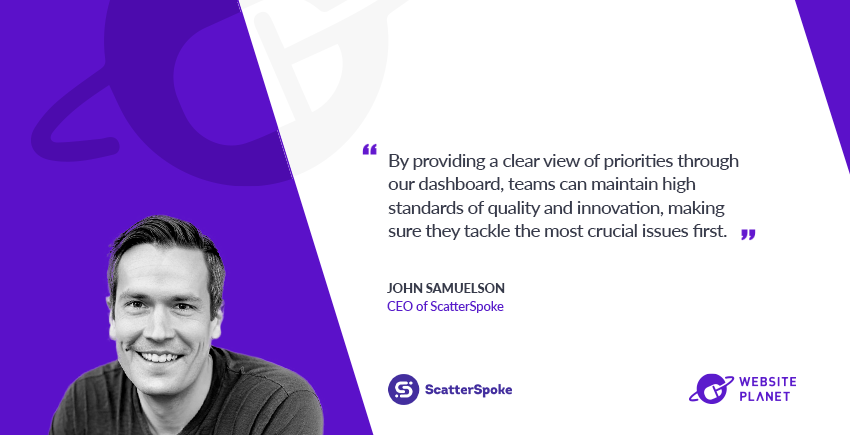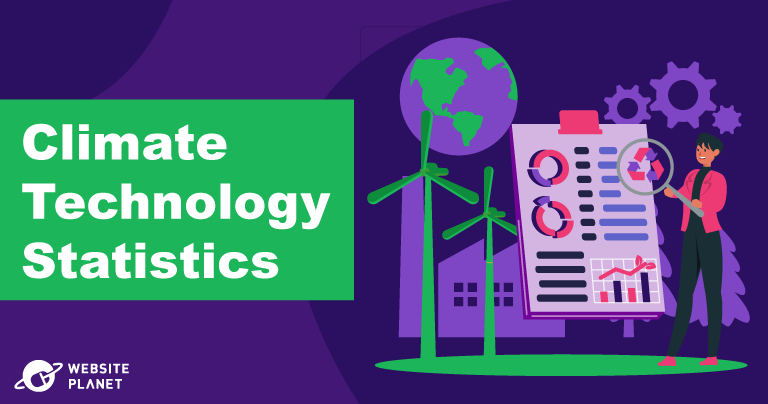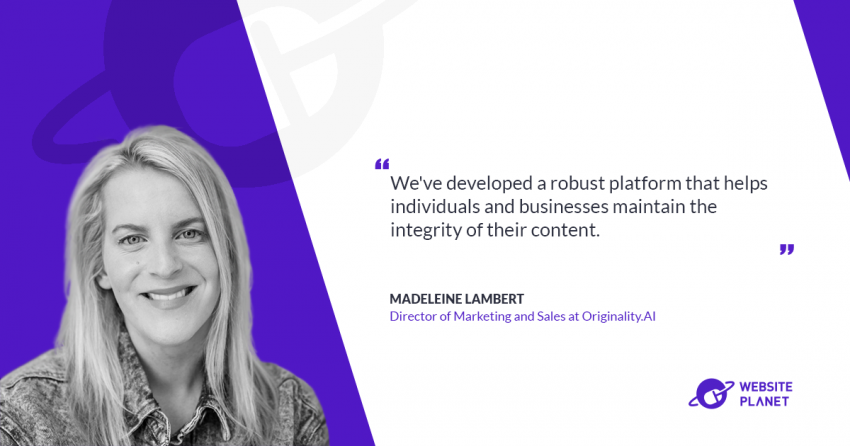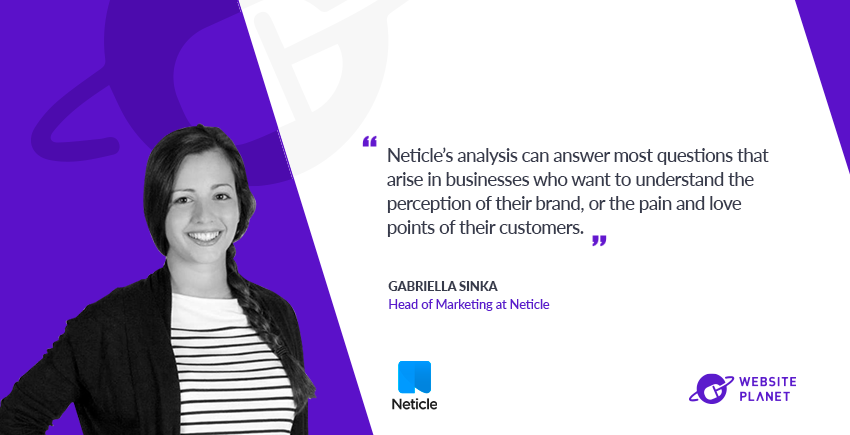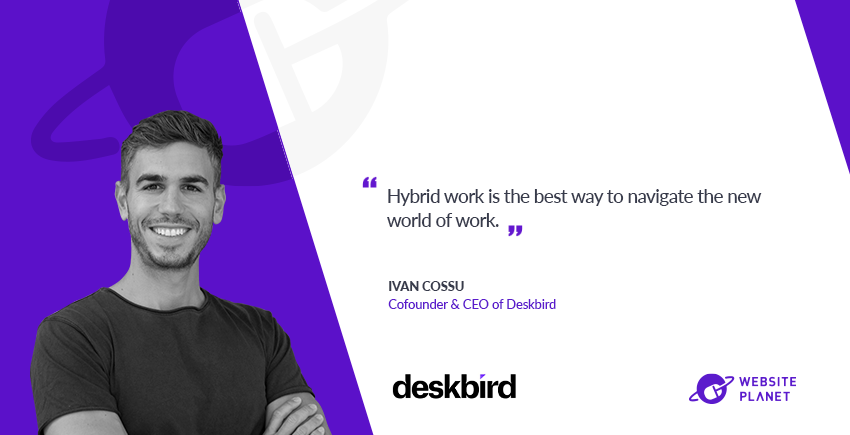Inside this Article
Personalization Industry Overview
We’ll start this article off with a quick look at some general statistics about personalization. Do consumers like personalization? Are marketers getting results from individualized communications? And what else can we learn about the current state of personalization and personalized marketing?1. Consumers Buy Because of Personalization
 Let’s get one thing straight: people absolutely love personalization. Customers love it so much that their purchasing behavior often hinges on the success of personalization elements.
Amongst other benefits, personalization streamlines the customer journey by elevating the customer’s experience. More relevancy, value, and ease-of-use often translates into a happy customer — and a happy customer is more likely to buy your product or service.
Let’s get one thing straight: people absolutely love personalization. Customers love it so much that their purchasing behavior often hinges on the success of personalization elements.
Amongst other benefits, personalization streamlines the customer journey by elevating the customer’s experience. More relevancy, value, and ease-of-use often translates into a happy customer — and a happy customer is more likely to buy your product or service.
2. Consumers Will Share Data for Better Personalization
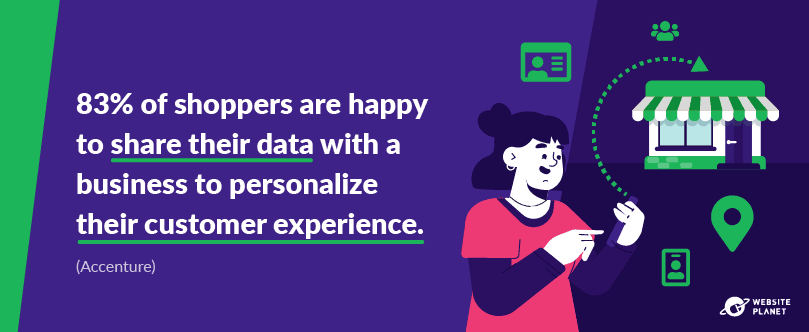 Customers are actually willing to surrender their precious data if it means their experience with your brand is improved.
Over half of shoppers are willing to share their data if they receive personalized offers in return. More than 8 out of 10 customers will give information for a generally personalized experience.
That means marketers have no excuse for failing to collect relevant data, or failing to implement personalization tactics at all. Customers want personalized elements, so give them what they want!
Customers are actually willing to surrender their precious data if it means their experience with your brand is improved.
Over half of shoppers are willing to share their data if they receive personalized offers in return. More than 8 out of 10 customers will give information for a generally personalized experience.
That means marketers have no excuse for failing to collect relevant data, or failing to implement personalization tactics at all. Customers want personalized elements, so give them what they want!
3. Bad Personalization Is Not an Option
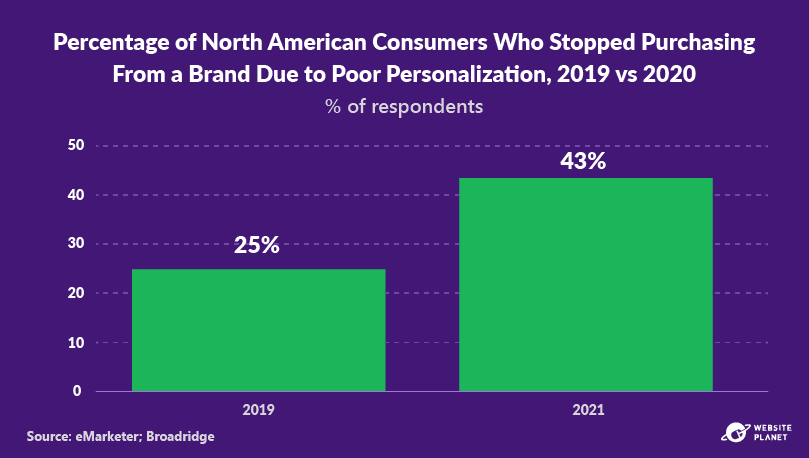 Bad personalization, or no personalization, is simply not an option.
Giant corporations like Amazon invest heavily in personalization and customer experience — which means there are plenty of easily accessible alternatives customers can seek out if your business’ buyer journey is not seamless.
Consumers flat-out ditch brands that fail with personalization. This is not only because people crave a simple experience; people get annoyed with outdated and irrelevant marketing tactics in 2021.
63% of consumers get “highly annoyed” when businesses rely on generic messaging and good ol’ fashioned ad blasting (Marketo).
Another 74% get frustrated when communications from a brand are irrelevant (Onespot).
So, a good level of personalization across all channels is important. In fact, customers expect it…
Bad personalization, or no personalization, is simply not an option.
Giant corporations like Amazon invest heavily in personalization and customer experience — which means there are plenty of easily accessible alternatives customers can seek out if your business’ buyer journey is not seamless.
Consumers flat-out ditch brands that fail with personalization. This is not only because people crave a simple experience; people get annoyed with outdated and irrelevant marketing tactics in 2021.
63% of consumers get “highly annoyed” when businesses rely on generic messaging and good ol’ fashioned ad blasting (Marketo).
Another 74% get frustrated when communications from a brand are irrelevant (Onespot).
So, a good level of personalization across all channels is important. In fact, customers expect it…
4. Customers Expect Personalization
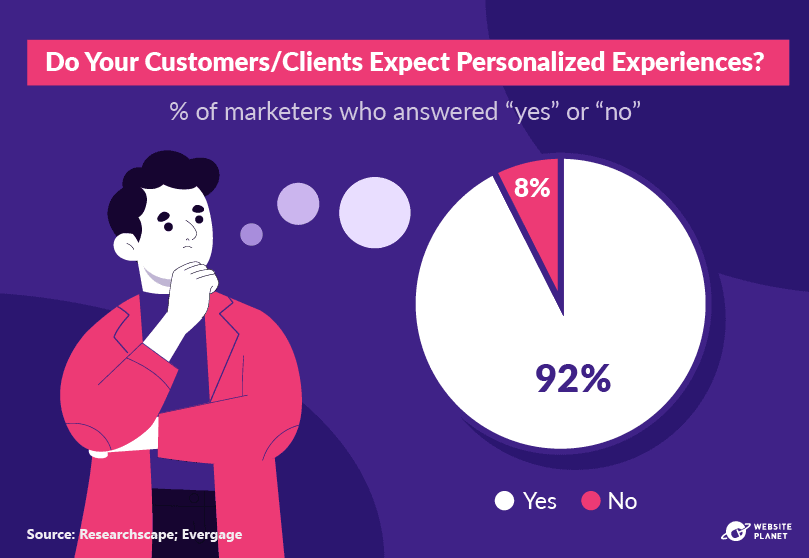 In an excellent recent survey by Researchscape and Evergage, the question was posed: do customers expect personalization elements from a business? The response from marketers was overwhelming…
A staggering 92% of marketers firmly believe personalization is a minimum requirement in the eyes of the consumer. That explains why bad personalization is such a turn-off for the average person.
In 2019, Researchscape’s analysis found that 85% of marketers expect personalization elements. Clearly, we’re moving towards a world where personalization is normal.
In an excellent recent survey by Researchscape and Evergage, the question was posed: do customers expect personalization elements from a business? The response from marketers was overwhelming…
A staggering 92% of marketers firmly believe personalization is a minimum requirement in the eyes of the consumer. That explains why bad personalization is such a turn-off for the average person.
In 2019, Researchscape’s analysis found that 85% of marketers expect personalization elements. Clearly, we’re moving towards a world where personalization is normal.
5. Personalization is Memorable
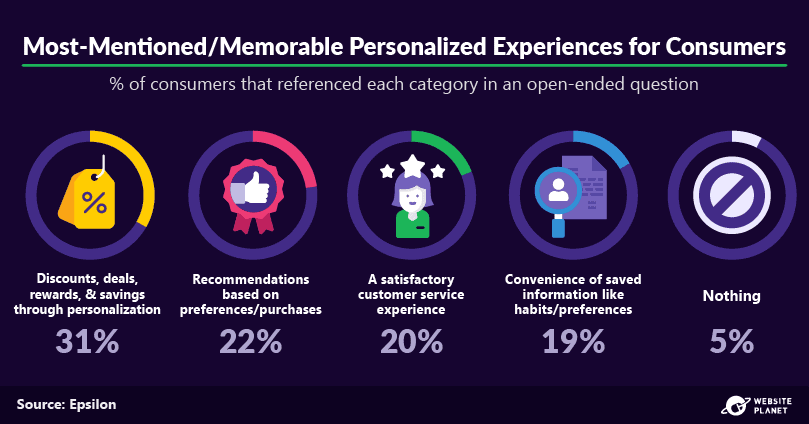 Which personalized experiences stick out in the average customer’s memory? Epilson’s research should help us answer that question.
Discounts, deals, rewards, savings, coupons, you name it. If personalization is helping customers get a better deal, it lives long in the memory.
Helpful personalized elements bring value to the customer in other ways, too.
22% of consumers remembered an effective recommendation, 19% of shoppers remembered the convenience of their saved information, and 20% remembered an overall satisfactory customer experience.
Which personalized experiences stick out in the average customer’s memory? Epilson’s research should help us answer that question.
Discounts, deals, rewards, savings, coupons, you name it. If personalization is helping customers get a better deal, it lives long in the memory.
Helpful personalized elements bring value to the customer in other ways, too.
22% of consumers remembered an effective recommendation, 19% of shoppers remembered the convenience of their saved information, and 20% remembered an overall satisfactory customer experience.
6. Marketers Using Personalization See Huge Improvements
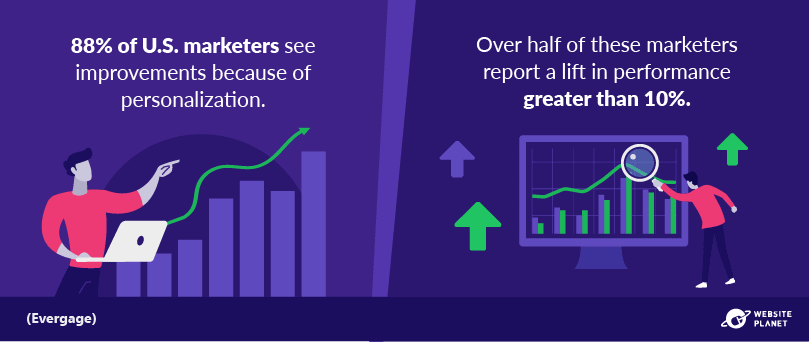 Providing value to the customer, whether that is monetary or otherwise, brings measurable results. Nearly 9 out of 10 marketers agree, and for over half of these marketers the improvements are substantial.
Personalized tactics have the potential to improve a range of performance metrics, from leads to conversions, sales, revenue, engagement, and more.
That’s why, according to Instapage, marketers who use personalized experiences see their sales increase by 20% on average.
Providing value to the customer, whether that is monetary or otherwise, brings measurable results. Nearly 9 out of 10 marketers agree, and for over half of these marketers the improvements are substantial.
Personalized tactics have the potential to improve a range of performance metrics, from leads to conversions, sales, revenue, engagement, and more.
That’s why, according to Instapage, marketers who use personalized experiences see their sales increase by 20% on average.
7. What Are the Benefits of Personalization?
 Now’s a good time to look at the biggest benefits that can be gleaned from personalization.
Enhancing the customer’s experience is the biggest benefit of personalized marketing tactics.
Whether that means implementing product recommendations on an eCommerce site or streamlining the purchasing process for customers, customer experience has a direct effect on all of those performance metrics we listed on the previous point.
Conversion rates are far higher for marketers using personalization, as is engagement. That’s because personalization can be used to tailor marketing messages, too — like emails, SMS alerts, and social media messages.
Brand perception, customer loyalty, and acquisitions are 3 more areas that receive a boost from personalized tactics.
Now’s a good time to look at the biggest benefits that can be gleaned from personalization.
Enhancing the customer’s experience is the biggest benefit of personalized marketing tactics.
Whether that means implementing product recommendations on an eCommerce site or streamlining the purchasing process for customers, customer experience has a direct effect on all of those performance metrics we listed on the previous point.
Conversion rates are far higher for marketers using personalization, as is engagement. That’s because personalization can be used to tailor marketing messages, too — like emails, SMS alerts, and social media messages.
Brand perception, customer loyalty, and acquisitions are 3 more areas that receive a boost from personalized tactics.
8. Customer Experience Is the Key Driver
 What are the drivers behind adoption in marketing organizations? The graph shows that marketers do not simply want to “increase revenue” with their personalized efforts.
Customer experience remains at the heart of personalization, and marketers know that they can expect financial gains further down the line where CX is concerned.
The second driver of adoption is organizations’ desire to build loyalty amongst users, which comes from individualized communications and ease of use.
Again, the focus is on providing value, with revenue gains expected as a result.
What are the drivers behind adoption in marketing organizations? The graph shows that marketers do not simply want to “increase revenue” with their personalized efforts.
Customer experience remains at the heart of personalization, and marketers know that they can expect financial gains further down the line where CX is concerned.
The second driver of adoption is organizations’ desire to build loyalty amongst users, which comes from individualized communications and ease of use.
Again, the focus is on providing value, with revenue gains expected as a result.
9. Do Marketers Hit Their Personalization Goals?
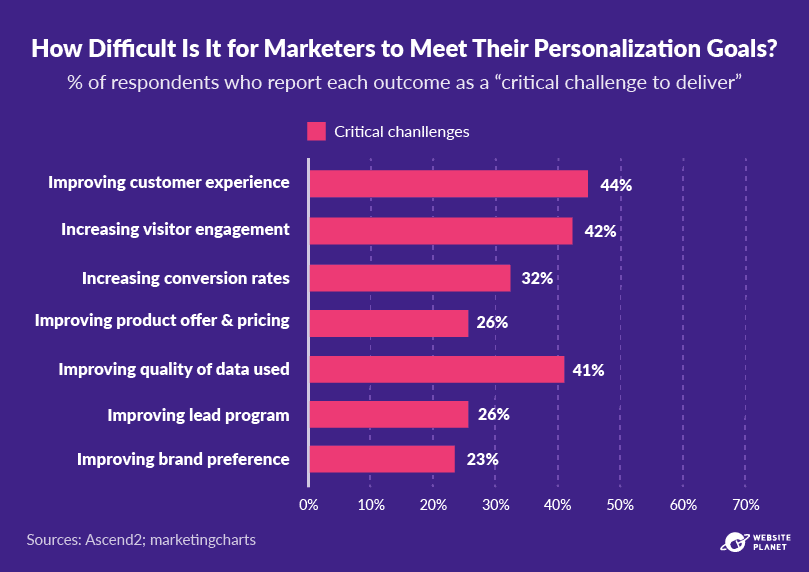 Marketers in an Ascend2 survey were asked to describe which personalization goals were proving the most difficult to achieve.
44% of marketers were finding their goal of “improving customer experience” a challenge.
“Improving engagement” was also a difficult goal to achieve for 42% of marketers, while “improving the quality of data used” was another major difficulty. 41% of marketers described this as a “critical challenge.”
Marketers in an Ascend2 survey were asked to describe which personalization goals were proving the most difficult to achieve.
44% of marketers were finding their goal of “improving customer experience” a challenge.
“Improving engagement” was also a difficult goal to achieve for 42% of marketers, while “improving the quality of data used” was another major difficulty. 41% of marketers described this as a “critical challenge.”
10. Personalization Builds Customer Relations
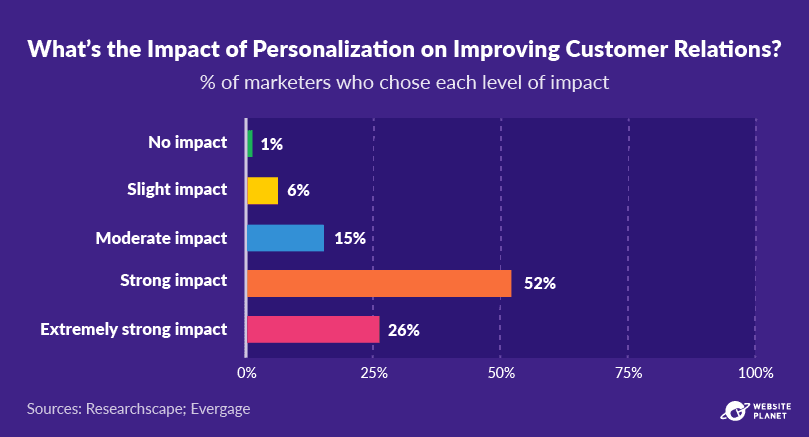 Marketers clearly believe their personalization efforts are working on this front. 52% of marketers say personalization has a “strong impact” on customer relations, while another 26% cite an “extremely strong impact.”
In total, 99% of marketers think that personalization advances customer relations to some degree.
Personalization improves customer relations because it shows customers/clients that you understand what they need. By streamlining the customer’s experience and providing relevant recommendations, businesses can demonstrate that they are willing to provide that value.
Fostering this kind of trust is important. 70% of consumers say that a business’ understanding of their personal needs can positively or negatively affect their loyalty to that brand.
Marketers clearly believe their personalization efforts are working on this front. 52% of marketers say personalization has a “strong impact” on customer relations, while another 26% cite an “extremely strong impact.”
In total, 99% of marketers think that personalization advances customer relations to some degree.
Personalization improves customer relations because it shows customers/clients that you understand what they need. By streamlining the customer’s experience and providing relevant recommendations, businesses can demonstrate that they are willing to provide that value.
Fostering this kind of trust is important. 70% of consumers say that a business’ understanding of their personal needs can positively or negatively affect their loyalty to that brand.
11. Brand Loyalty = Repeat Customers
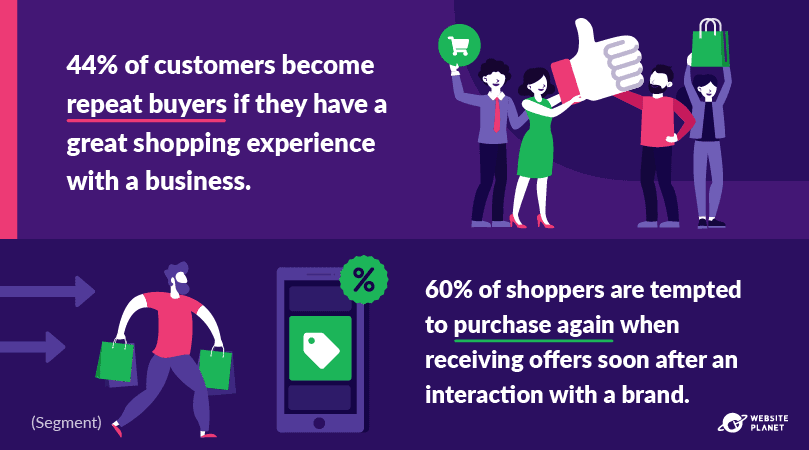 Creating a loyal customer base is important for marketers using personalization because it promotes repeated transactions.
In fact, customer experience and personalized offers are direct drivers of repeat transactions, particularly within the B2C marketing sector.
In reality, you could apply this rule to any business or industry. Provide a satisfactory service to customers, and they will keep coming back for more.
Creating a loyal customer base is important for marketers using personalization because it promotes repeated transactions.
In fact, customer experience and personalized offers are direct drivers of repeat transactions, particularly within the B2C marketing sector.
In reality, you could apply this rule to any business or industry. Provide a satisfactory service to customers, and they will keep coming back for more.
12. How Many Marketers Use Personalization?
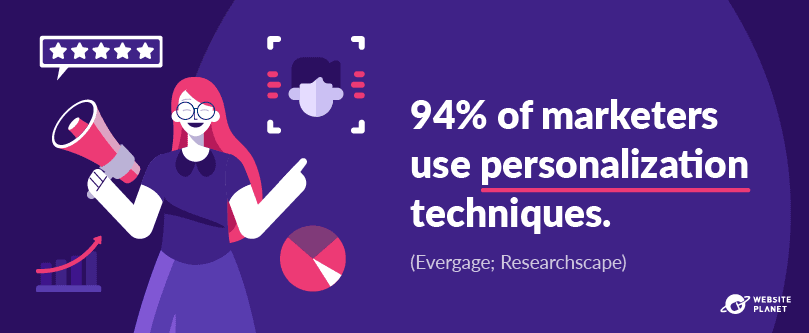 Personalization is a widely adopted tactic by marketers around the world. More than 9 out of every 10 marketers are now utilizing personalization techniques in their marketing strategy.
The benefits of personalization are countless, and it remains to be said: if you’re not using personalization in 2021, you‘re missing out.
Personalization is a widely adopted tactic by marketers around the world. More than 9 out of every 10 marketers are now utilizing personalization techniques in their marketing strategy.
The benefits of personalization are countless, and it remains to be said: if you’re not using personalization in 2021, you‘re missing out.
13. Obstacles to Adoption of Personalization
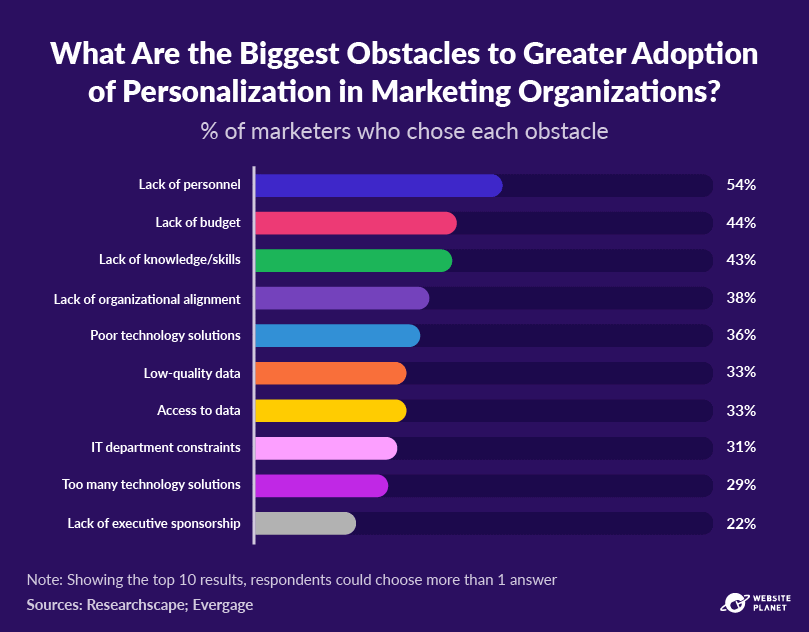 An overwhelming number of businesses see the value in personalization, so what’s stopping brands from using personalization techniques? And why are marketers struggling to upscale their personalization campaigns?
Businesses and organizations lack enough specialized personnel, and this is a major obstacle to greater adoption.
Marketers may require specialist opinions from analysts and, at times, behavioral scientists. In any case, finding marketers with experience in personalization is difficult, and — as we’ll show you — experience is important to successful personalization.
A lack of budget is the second biggest obstacle to greater adoption. Unsurprising, given that 40% of executives in a Harvard study feel AI initiatives are expensive.
Many marketers lack knowledge/experience of personalization. Without much help from specialized staff members, a number of marketers would rather carry on with tried-and-tested tactics.
An overwhelming number of businesses see the value in personalization, so what’s stopping brands from using personalization techniques? And why are marketers struggling to upscale their personalization campaigns?
Businesses and organizations lack enough specialized personnel, and this is a major obstacle to greater adoption.
Marketers may require specialist opinions from analysts and, at times, behavioral scientists. In any case, finding marketers with experience in personalization is difficult, and — as we’ll show you — experience is important to successful personalization.
A lack of budget is the second biggest obstacle to greater adoption. Unsurprising, given that 40% of executives in a Harvard study feel AI initiatives are expensive.
Many marketers lack knowledge/experience of personalization. Without much help from specialized staff members, a number of marketers would rather carry on with tried-and-tested tactics.
14. Marketers Want More Data for Personalization
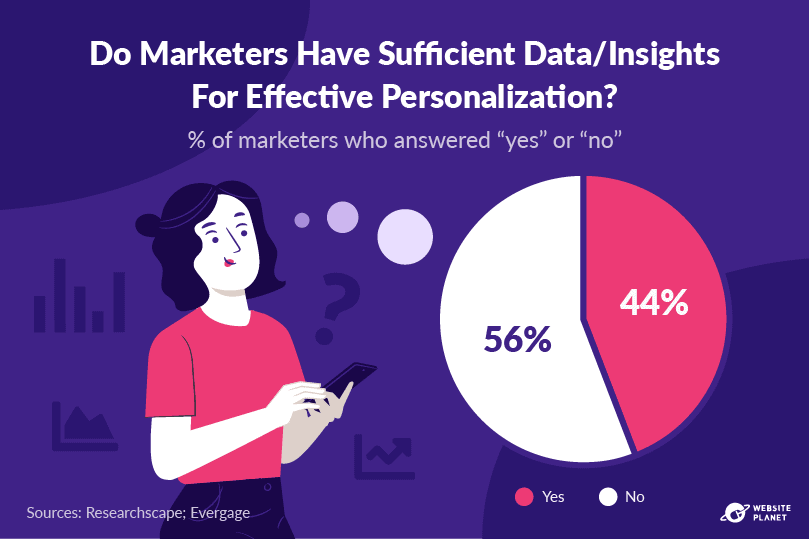 56% of marketers in Researchscape and Evergage’s study believe they do not have enough data to carry out an effective level of personalization. This ranked as one of the obstacles to greater adoption, too.
The study also found that this is a B2B-specific problem. 64% of B2B marketers said they do not have enough data for personalization.
We’ve already established that your average consumer is willing to give over information. Gathering information from customers is easy if you have a popular website receiving countless visits every day.
But what do you do when you need another business’s information?
B2B marketers are still trying to work this one out, it seems. With less traffic and niche leads, gathering data when you have such a small client base to work with is proving difficult.
56% of marketers in Researchscape and Evergage’s study believe they do not have enough data to carry out an effective level of personalization. This ranked as one of the obstacles to greater adoption, too.
The study also found that this is a B2B-specific problem. 64% of B2B marketers said they do not have enough data for personalization.
We’ve already established that your average consumer is willing to give over information. Gathering information from customers is easy if you have a popular website receiving countless visits every day.
But what do you do when you need another business’s information?
B2B marketers are still trying to work this one out, it seems. With less traffic and niche leads, gathering data when you have such a small client base to work with is proving difficult.
15. More Professional Experience Helps Boost Personalization Efforts
 Experience counts when it comes to personalization. Knowing how to implement these technologies to their ultimate potential sees a tangible return on results.
That’s why newbies report being “extremely satisfied” with their efforts 0% of the time. Marketers with three to five years of experience with personalization are extremely satisfied 33% of the time, while marketers with 5+ years experience get maximum satisfaction 67% of the time.
The theme is the same across every level of satisfaction “moderate” or above. Experience really pays off with personalization.
Hard work always seems to provide results, too. Just 14% of marketers with 5+ years of experience in personalization reported unsatisfactory results.
Experience counts when it comes to personalization. Knowing how to implement these technologies to their ultimate potential sees a tangible return on results.
That’s why newbies report being “extremely satisfied” with their efforts 0% of the time. Marketers with three to five years of experience with personalization are extremely satisfied 33% of the time, while marketers with 5+ years experience get maximum satisfaction 67% of the time.
The theme is the same across every level of satisfaction “moderate” or above. Experience really pays off with personalization.
Hard work always seems to provide results, too. Just 14% of marketers with 5+ years of experience in personalization reported unsatisfactory results.
16. What Challenges Do Marketers Using Personalization Face?
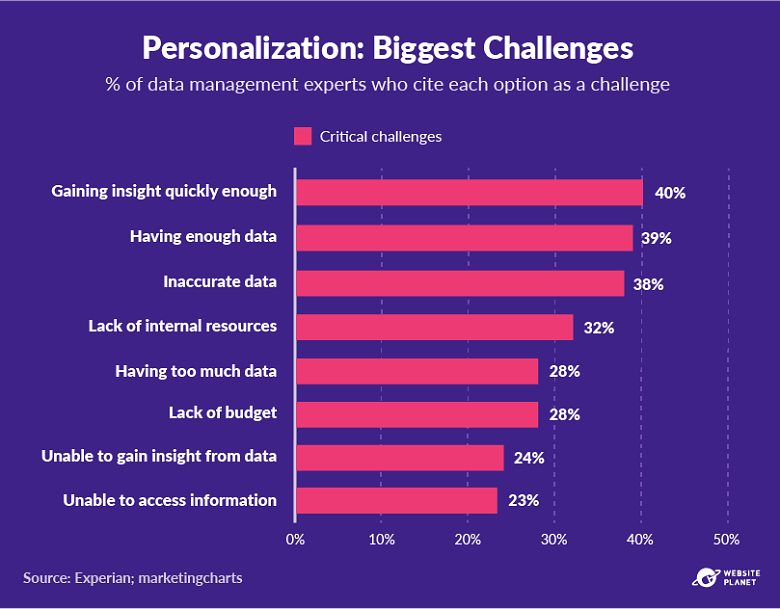 Data returns as a key theme when we look at the biggest challenges for marketers already using personalization. You need a lot of data to create and maintain a personalization strategy, and collecting enough of it can be a problem.
Sometimes this data is not accurate, which can result in a poor level of personalization. This was a problem for 38% of respondents. The biggest problem, however, was responsiveness. 40% of marketers lost any positive effects because they could not gain insight quickly enough.
That’s important because customers expect a rapid response from brands. In a Segment survey, 54% of consumers said they expect to receive personalized discounts within 24 hours of submitting their data to a brand. 32% expect personalized offers within an hour.
In the digital field specifically, marketers are short on proper tools to get the job done. According to BloomReach, 51% of digital marketers say they lack the proper technology to create personalized experiences.
Data returns as a key theme when we look at the biggest challenges for marketers already using personalization. You need a lot of data to create and maintain a personalization strategy, and collecting enough of it can be a problem.
Sometimes this data is not accurate, which can result in a poor level of personalization. This was a problem for 38% of respondents. The biggest problem, however, was responsiveness. 40% of marketers lost any positive effects because they could not gain insight quickly enough.
That’s important because customers expect a rapid response from brands. In a Segment survey, 54% of consumers said they expect to receive personalized discounts within 24 hours of submitting their data to a brand. 32% expect personalized offers within an hour.
In the digital field specifically, marketers are short on proper tools to get the job done. According to BloomReach, 51% of digital marketers say they lack the proper technology to create personalized experiences.
17. Are Marketers Getting It Right?
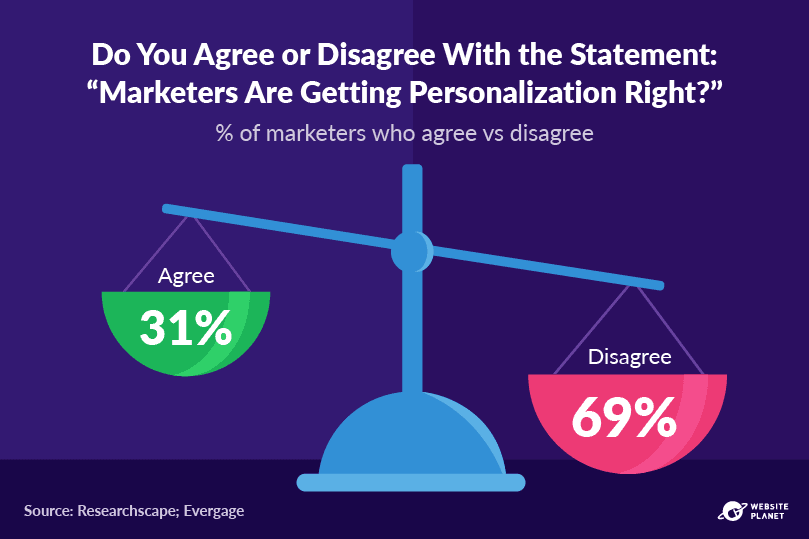 By and large, marketers feel they still have a long way to go before fully realizing the potential of personalization.
That’s despite the fact that personalization has been around for several years now. But nobody said this would be easy.
Perhaps a portion of the difficulties lie in the challenges marketers face towards greater adoption. Researchscape and Evergage asked marketers if they believe personalization should be a bigger part of their organization. 85% of marketers said that, undoubtedly, personalization should be a bigger priority.
The fact businesses are seeing returns within this context owes to the vast potential of personalization techniques. We may not know the true extent of that potential until brands fully adopt personalization.
By and large, marketers feel they still have a long way to go before fully realizing the potential of personalization.
That’s despite the fact that personalization has been around for several years now. But nobody said this would be easy.
Perhaps a portion of the difficulties lie in the challenges marketers face towards greater adoption. Researchscape and Evergage asked marketers if they believe personalization should be a bigger part of their organization. 85% of marketers said that, undoubtedly, personalization should be a bigger priority.
The fact businesses are seeing returns within this context owes to the vast potential of personalization techniques. We may not know the true extent of that potential until brands fully adopt personalization.
Personalization Adoption in Different Industries
Which industries are the major exponents of personalization? The retail sector is the perfect place to implement AI product recommendations, personalized offers, and enhanced buyer journeys — so it stands to profit most from personalization. Other industries are adopting personalization too though, and many of these could make a healthy return in the future.18. Retail/eCommerce Adoption
 The retail and eCommerce sector is the number one industry using personalization tactics. According to The Relevancy Group, 86% of all retail brands are investing in personalization tactics, which is more than any other sector.
Product purchase recommendations are the number 1 personalization priority for 36% of retailers (Boston Retail Partners). These features essentially allow retailers to upsell relevant products to the customer.
Food & drink retailers have the lowest level of adoption amongst all retailers, while Media retailers have the highest level of adoption. That makes sense, given this subsector revolves around personal taste.
The retail and eCommerce sector is the number one industry using personalization tactics. According to The Relevancy Group, 86% of all retail brands are investing in personalization tactics, which is more than any other sector.
Product purchase recommendations are the number 1 personalization priority for 36% of retailers (Boston Retail Partners). These features essentially allow retailers to upsell relevant products to the customer.
Food & drink retailers have the lowest level of adoption amongst all retailers, while Media retailers have the highest level of adoption. That makes sense, given this subsector revolves around personal taste.
19. Retail/eCommerce Personalization Tactics
 While we’re here, let’s take a look at the personalization tactics used by retail/eCommerce businesses.
Personal touches to email marketing communications occupy the first 3 positions. Email is one of the most effective marketing channels for businesses, and those utilizing personalized elements can expect a big increase in revenue from their campaigns.
Retail businesses are also using a range of customer data sets to provide rules-based offers to customers. Meanwhile, real-time personalization features as another way to provide customers with AI-led product recommendations while using eCommerce sites.
General customer UX features heavily in retail too. 52% of retail organizations are personalizing their website, and another 31% plan on doing this in the future.
While we’re here, let’s take a look at the personalization tactics used by retail/eCommerce businesses.
Personal touches to email marketing communications occupy the first 3 positions. Email is one of the most effective marketing channels for businesses, and those utilizing personalized elements can expect a big increase in revenue from their campaigns.
Retail businesses are also using a range of customer data sets to provide rules-based offers to customers. Meanwhile, real-time personalization features as another way to provide customers with AI-led product recommendations while using eCommerce sites.
General customer UX features heavily in retail too. 52% of retail organizations are personalizing their website, and another 31% plan on doing this in the future.
20. The Travel Industry is Adopting Personalized Messaging
 Retail uses personalization for a range of purposes, but what other industries are adopting the tactic?
According to SmarterHQ’s study, travel & hospitality employs personalized messaging techniques more often than other industries.
63% of travel & hospitality companies in SmarterHQ’s study report using individualized messaging rather than mass sends. That includes emails, social media messages, and SMS prompts.
Retail uses personalization for a range of purposes, but what other industries are adopting the tactic?
According to SmarterHQ’s study, travel & hospitality employs personalized messaging techniques more often than other industries.
63% of travel & hospitality companies in SmarterHQ’s study report using individualized messaging rather than mass sends. That includes emails, social media messages, and SMS prompts.
21. Messaging Tactics Are Changing
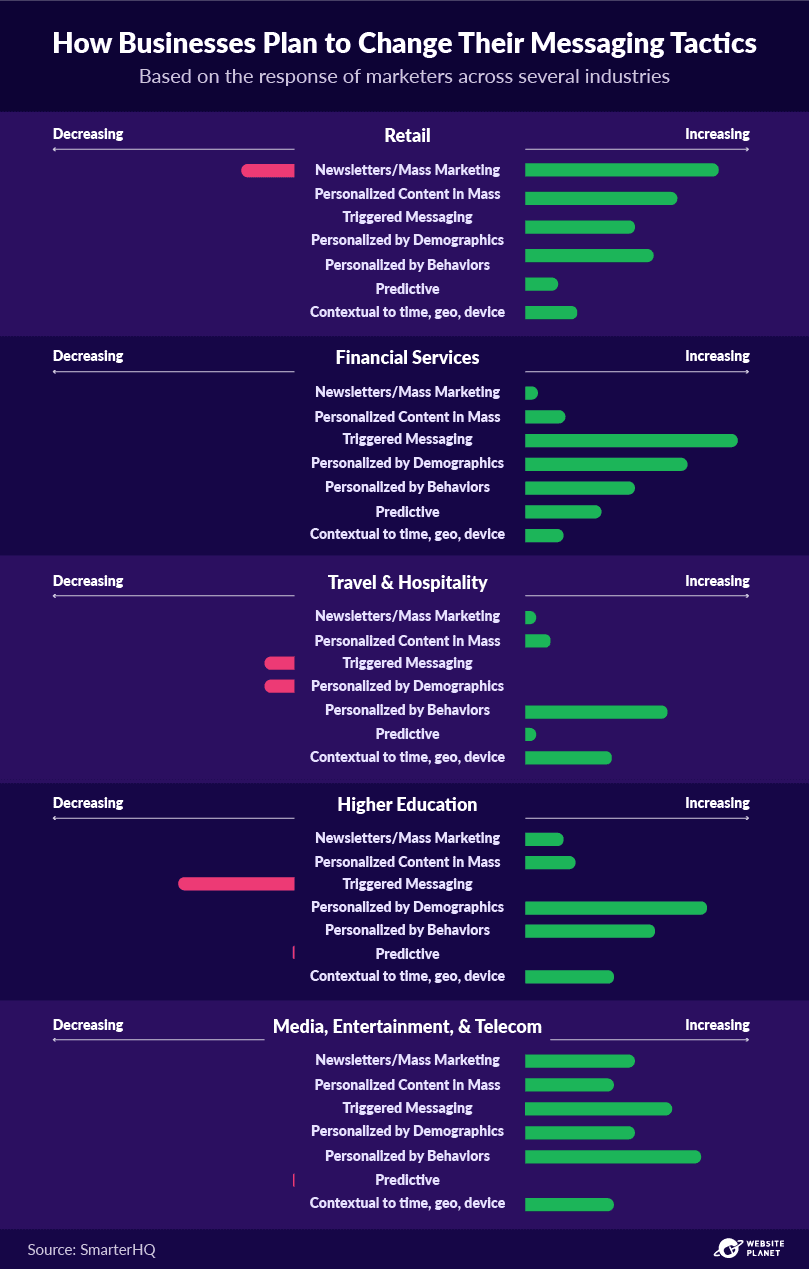 SmarterHQ also asked businesses where their messaging campaigns are headed.
Personalization seems to be the focus for most sectors. While retail will concentrate on personalized content, financial services will be looking at a greater amount of triggered messaging. This is when a brand sends a message or alert in response to a client/customer’s action.
Higher education organizations will look into demographics-based messaging, and media companies will personalize marketing efforts by behaviors.
The retail and financial sectors look like the biggest movers, while travel & hospitality will not be increasing personalized marketing efforts too much. This owes to the high level of current adoption.
SmarterHQ also asked businesses where their messaging campaigns are headed.
Personalization seems to be the focus for most sectors. While retail will concentrate on personalized content, financial services will be looking at a greater amount of triggered messaging. This is when a brand sends a message or alert in response to a client/customer’s action.
Higher education organizations will look into demographics-based messaging, and media companies will personalize marketing efforts by behaviors.
The retail and financial sectors look like the biggest movers, while travel & hospitality will not be increasing personalized marketing efforts too much. This owes to the high level of current adoption.
22. Which Industries Will Benefit Most From Personalization?
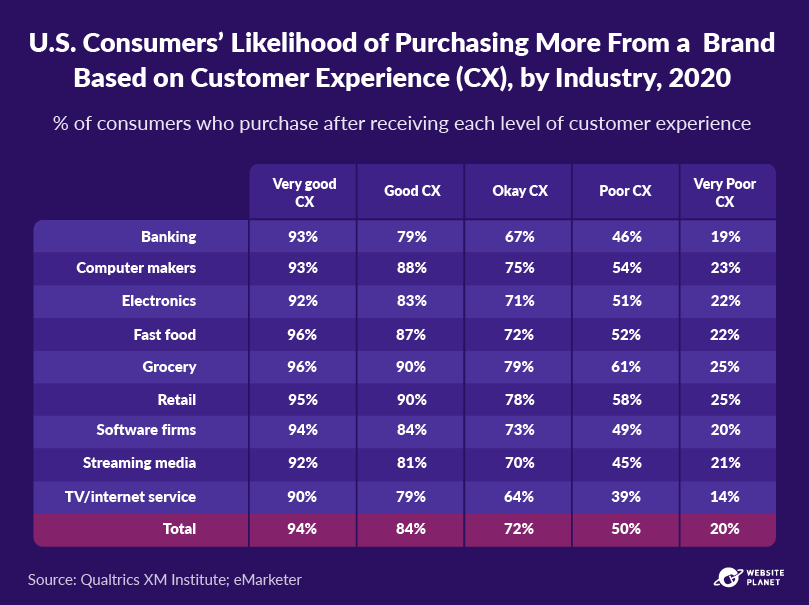 The above graphic outlines the potential benefits sectors could have from improving the customer’s experience with personalization.
Grocery brands have the lowest level of adoption amongst all retail sub-sectors, yet could perceivably benefit the most from improving the customer’s experience.
Software firms could see greater adoption too. Personalizing software programs to improve the customer’s experience could be crucial, and doing so will likely see advancements in sales and revenue for software firms.
The above graphic outlines the potential benefits sectors could have from improving the customer’s experience with personalization.
Grocery brands have the lowest level of adoption amongst all retail sub-sectors, yet could perceivably benefit the most from improving the customer’s experience.
Software firms could see greater adoption too. Personalizing software programs to improve the customer’s experience could be crucial, and doing so will likely see advancements in sales and revenue for software firms.
23. Retail Uses More Data for Personalization
 What data does retail collect to aid personalization efforts? And how does this compare to other industries?
Monetate’s research compares 3 key industries that are adopting personalization techniques. Retail, travel & hospitality, and insurance businesses all monitor users’ email activity to personalize email marketing campaigns.
On-site behavioral data is most important for insurance companies, while purchase history is far more relevant for retail brands.
In fact, basically every other form of data is more important to retail, which demonstrates the appreciation of personalization within the sector.
What data does retail collect to aid personalization efforts? And how does this compare to other industries?
Monetate’s research compares 3 key industries that are adopting personalization techniques. Retail, travel & hospitality, and insurance businesses all monitor users’ email activity to personalize email marketing campaigns.
On-site behavioral data is most important for insurance companies, while purchase history is far more relevant for retail brands.
In fact, basically every other form of data is more important to retail, which demonstrates the appreciation of personalization within the sector.
Impacts of Personalization on Marketing
What direct impacts on profitability can industries expect when implementing personalized elements? In this section, we’ll show you all the key metrics, from sales to revenue, return-on-investment, and the rest. These sales metrics primarily apply to retail transactions, but similar results can be expected across all industries.24. Personalization Reduces Acquisition Costs
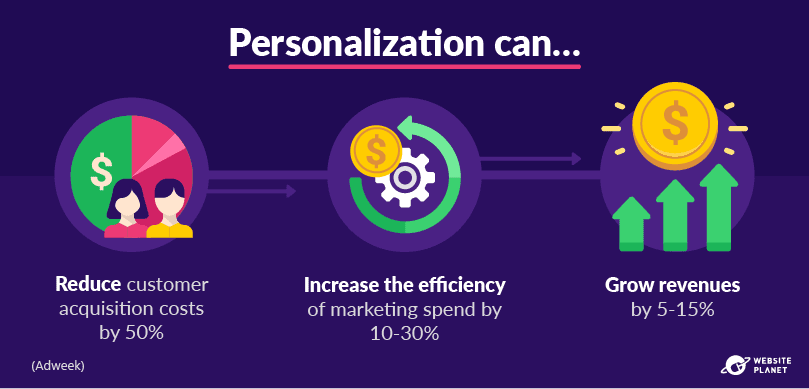 Implementing personalized elements into marketing materials reduced the cost of acquiring each customer.
Why? Personalized marketing tactics are more effective, so it stands to reason that marketers will save time, energy, and money when acquiring customers through personalized marketing.
Marketing spend efficiency and revenue increases for organizations using personalization, which means personalization offers a great return on investment.
Implementing personalized elements into marketing materials reduced the cost of acquiring each customer.
Why? Personalized marketing tactics are more effective, so it stands to reason that marketers will save time, energy, and money when acquiring customers through personalized marketing.
Marketing spend efficiency and revenue increases for organizations using personalization, which means personalization offers a great return on investment.
25. Personalization Improves ROI
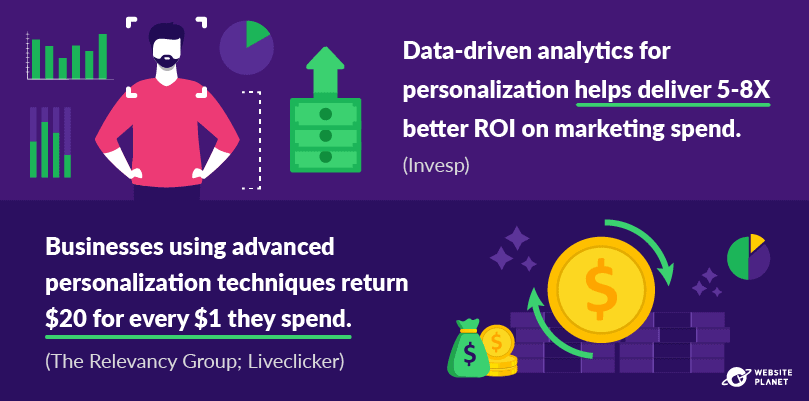 Personalization’s return on investment is significant. This return becomes larger as businesses choose to employ more advanced techniques.
For standard data-driven methods, marketers and businesses can still expect to see a massive ROI between 5 to 8 times their marketing spend.
Advanced personalization harbors the best results, however. Advanced methods include more expensive and comprehensive techniques than typical “rules-based” personalization.
AI predictive personalization is one such example. This technology can actually predict the behavior of customers.
Implementing systems like this sees the best return on investment. Businesses can make 20X their marketing spend with advanced personalization.
Personalization’s return on investment is significant. This return becomes larger as businesses choose to employ more advanced techniques.
For standard data-driven methods, marketers and businesses can still expect to see a massive ROI between 5 to 8 times their marketing spend.
Advanced personalization harbors the best results, however. Advanced methods include more expensive and comprehensive techniques than typical “rules-based” personalization.
AI predictive personalization is one such example. This technology can actually predict the behavior of customers.
Implementing systems like this sees the best return on investment. Businesses can make 20X their marketing spend with advanced personalization.
26. Retail Gets the Best ROI From Personalization
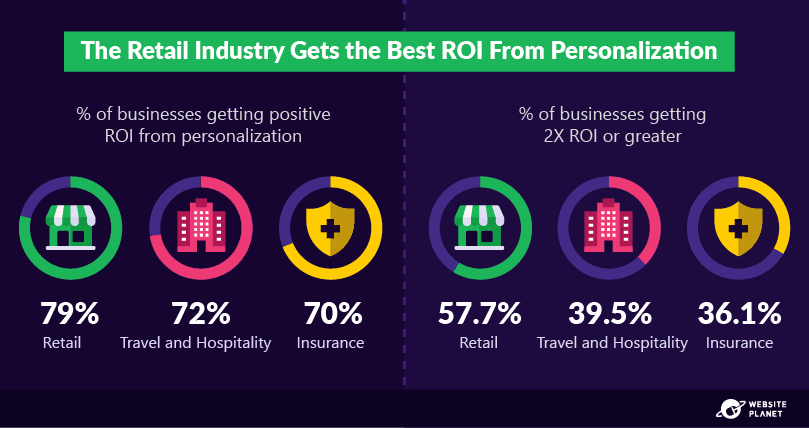 As can be seen in the above chart, most sectors get a positive ROI from personalized marketing. However, retail/eCommerce sees the best ROI of all.
A monetate survey found that, across 3 key industries, retail businesses are getting the best return from implementing personalization. 79% of surveyed retailers claim to receive a positive ROI from personalization, compared to 72% of travel & hospitality businesses and 70% of insurance companies.
The ROI retail brands receive is greater than other industries, too. Retail businesses are more likely to get 2X ROI or greater when using personalization tactics.
As can be seen in the above chart, most sectors get a positive ROI from personalized marketing. However, retail/eCommerce sees the best ROI of all.
A monetate survey found that, across 3 key industries, retail businesses are getting the best return from implementing personalization. 79% of surveyed retailers claim to receive a positive ROI from personalization, compared to 72% of travel & hospitality businesses and 70% of insurance companies.
The ROI retail brands receive is greater than other industries, too. Retail businesses are more likely to get 2X ROI or greater when using personalization tactics.
27. Personalized Recommendations Are Hugely Effective In Retail and eCommerce
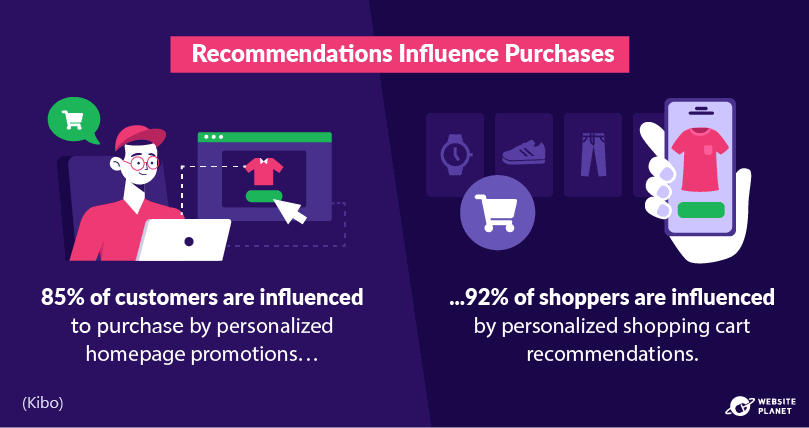 So why does the retail and eCommerce sector get such a fantastic return from personalization?
Personalization works perfectly for these businesses as they can tailor the customer’s experience in several ways.
Product promotions and recommendations are 2 of the primary ways in which retail/eCommerce marketers can drive sales through personalized techniques.
These tactics are extremely effective, too. Adding personalized homepage promotions influences 85% of consumers to buy, while shopping cart recommendations influencers 92%.
You should certainly try to utilize personalized product recommendations if you haven’t already, they work really well!
So why does the retail and eCommerce sector get such a fantastic return from personalization?
Personalization works perfectly for these businesses as they can tailor the customer’s experience in several ways.
Product promotions and recommendations are 2 of the primary ways in which retail/eCommerce marketers can drive sales through personalized techniques.
These tactics are extremely effective, too. Adding personalized homepage promotions influences 85% of consumers to buy, while shopping cart recommendations influencers 92%.
You should certainly try to utilize personalized product recommendations if you haven’t already, they work really well!
28. Personalization Increases Order Value in Retail
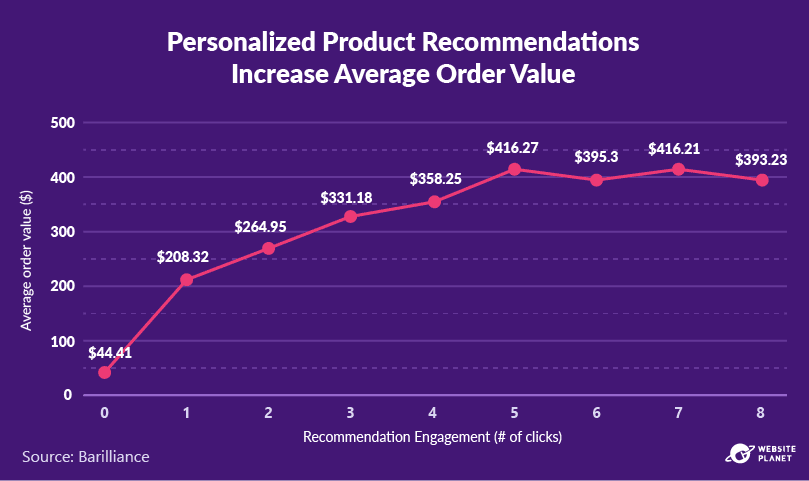 Personalizing the customer’s experience and streamlining the buyer’s journey has other positive effects. Namely, customers are more willing to spend their money when you provide them with these personalized recommendations.
Personalized recommendations, amongst other personalized marketing techniques, promote impulsive buying tendencies in customers.
Customers may fall in love with a product as soon as they see it recommended and will buy it instantly without worrying about the price. In a Segment survey, 40% of consumers said they have purchased a more expensive product because of a personalized experience.
Recommendations also encourage customers to add more products to their basket, increasing the value of their order.
Personalizing the customer’s experience and streamlining the buyer’s journey has other positive effects. Namely, customers are more willing to spend their money when you provide them with these personalized recommendations.
Personalized recommendations, amongst other personalized marketing techniques, promote impulsive buying tendencies in customers.
Customers may fall in love with a product as soon as they see it recommended and will buy it instantly without worrying about the price. In a Segment survey, 40% of consumers said they have purchased a more expensive product because of a personalized experience.
Recommendations also encourage customers to add more products to their basket, increasing the value of their order.
29. Personalization Reduces Cart Abandons
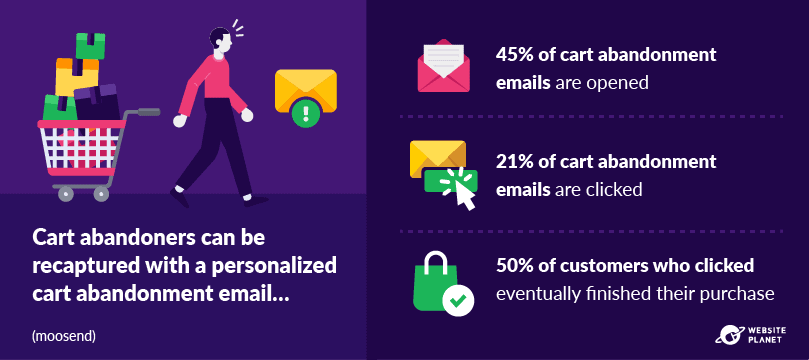 Cart abandons are a major problem in the eCommerce industry. Online shoppers abandon their carts around 70% of the time, a trend that sees eCommerce lose approximately $18 billion in revenue a year.
Fortunately, personalization can help reduce cart abandons in a few different ways. Shopping cart prompts, retargeting ads, automated messages, and general checkout optimization all help to streamline the buyer journey and promote conversions.
Abandonment emails are the easiest way to remind buyers to finish their purchase. Rip Curl, for example, saw a 10% increase in revenue when using a combination of abandonment emails and product recommendations.
Cart abandons are a major problem in the eCommerce industry. Online shoppers abandon their carts around 70% of the time, a trend that sees eCommerce lose approximately $18 billion in revenue a year.
Fortunately, personalization can help reduce cart abandons in a few different ways. Shopping cart prompts, retargeting ads, automated messages, and general checkout optimization all help to streamline the buyer journey and promote conversions.
Abandonment emails are the easiest way to remind buyers to finish their purchase. Rip Curl, for example, saw a 10% increase in revenue when using a combination of abandonment emails and product recommendations.
30. Retargeting Ads Work Too
 While we’re here, why not mention retargeted ads? You probably see a lot of these on your social media accounts…
Have you ever failed to finish a purchase, only to be flooded with ads of the same product?
That’s a retargeted ad, and it works really well for recapturing business from cart abandoners.
Engagement for retargeted ads is super high, as users are clearly forced to reconsider buying the product. Retargeting cart abandoners can see conversion rates increase by 26% as a result.
While we’re here, why not mention retargeted ads? You probably see a lot of these on your social media accounts…
Have you ever failed to finish a purchase, only to be flooded with ads of the same product?
That’s a retargeted ad, and it works really well for recapturing business from cart abandoners.
Engagement for retargeted ads is super high, as users are clearly forced to reconsider buying the product. Retargeting cart abandoners can see conversion rates increase by 26% as a result.
31. Chatbots Help With Customer Service
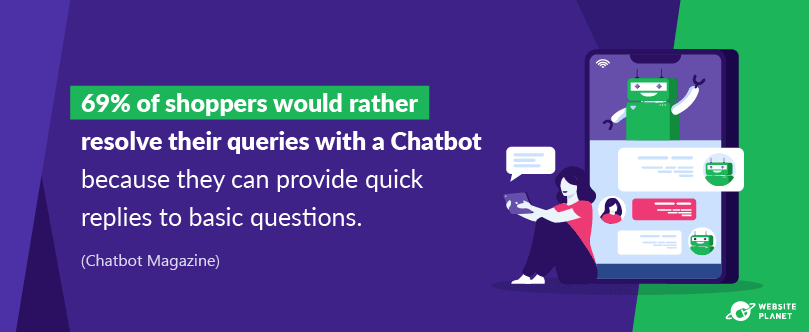 Chatbots help reduce cart abandonments by prompting customers and solving any problems they may have quickly.
Chatbots can be a form of triggered messaging influenced by AI. Chatbots can send product recommendations, purchase prompts, or answer customer queries by using the customer’s data to inform its decisions.
People enjoy the simplicity and ease of communicating with a chatbot. That’s why they are such an effective aid to the customer’s experience, especially for eCommerce businesses.
Chatbots help reduce cart abandonments by prompting customers and solving any problems they may have quickly.
Chatbots can be a form of triggered messaging influenced by AI. Chatbots can send product recommendations, purchase prompts, or answer customer queries by using the customer’s data to inform its decisions.
People enjoy the simplicity and ease of communicating with a chatbot. That’s why they are such an effective aid to the customer’s experience, especially for eCommerce businesses.
32. Personalization Increases Add-to-Carts and Conversions
 “Add-to-carts” and conversions are improved massively by personalized elements.
The add-to-cart rate does not change significantly for the first 1 or 2 personalized pages that a customer sees on a company website. Customers are likely browsing products/services in these initial stages, and are not ready to commit to a purchase.
The effects of personalization on conversion rate are still measurable at this stage of the buyer’s journey. Personalization does have a cumulative effect. After the customer sees 10 personalized pages, add-to-cart rates and conversion rates increase greatly.
Add-to-carts rise from 3.4% on the 3rd personalized pageview to 31.6% on the 10th.
Conversions rise from 16.7% to 65.2% on the 10th pageview. This increase in conversions demonstrates why personalization has such a huge effect on revenue.
“Add-to-carts” and conversions are improved massively by personalized elements.
The add-to-cart rate does not change significantly for the first 1 or 2 personalized pages that a customer sees on a company website. Customers are likely browsing products/services in these initial stages, and are not ready to commit to a purchase.
The effects of personalization on conversion rate are still measurable at this stage of the buyer’s journey. Personalization does have a cumulative effect. After the customer sees 10 personalized pages, add-to-cart rates and conversion rates increase greatly.
Add-to-carts rise from 3.4% on the 3rd personalized pageview to 31.6% on the 10th.
Conversions rise from 16.7% to 65.2% on the 10th pageview. This increase in conversions demonstrates why personalization has such a huge effect on revenue.
Personalization Channels & Formats
Here we’ll take a look at channels, locations, and formats through which marketers can deliver personalized experiences. What kind of impacts can be expected across different channels? And what are the key techniques and tactics for driving action within them?33. Which Channels Are Most Important For Personalization?
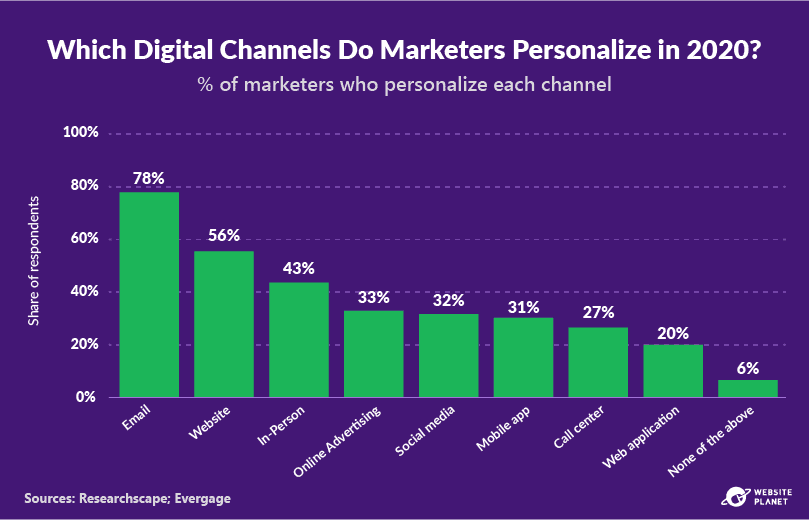 A Researchscape study demonstrates that email is the most popular channel that marketers personalized in 2020.
78% of marketers who use personalization utilized these techniques on email, while another 56% of respondents personalized their business’ website.
Personalizing the customer’s in-store experience was the third biggest priority for marketers, while the personalization of mobile apps and social media communications was further down the rankings.
A Researchscape study demonstrates that email is the most popular channel that marketers personalized in 2020.
78% of marketers who use personalization utilized these techniques on email, while another 56% of respondents personalized their business’ website.
Personalizing the customer’s in-store experience was the third biggest priority for marketers, while the personalization of mobile apps and social media communications was further down the rankings.
34. Some Channels Drive Impulsive Buys
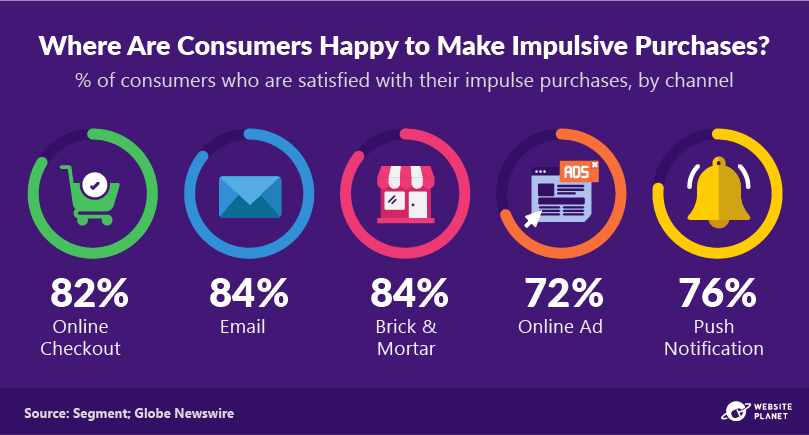 We mentioned the effect of product recommendations on impulsive buying, but placing personalized content across online checkout, email, brick & mortar, online ads, and push notifications can have a huge effect too.
According to Segment, these are 5 of the biggest channels for impulsive buying.
Push notifications appear on a user’s device to convince them to visit your site/app or tell them about an offer they can claim in-store or online. 76% of consumers impulsively bought a product through this channel and were happy with the results.
Online checkout, email, and brick-and-mortar are 3 other areas where personalized recommendations can have a big effect, while 72% of consumers were satisfied when buying impulsively because of an ad.
Personalization leads to a high level of customer satisfaction. Just 5% of respondents returned a product they bought “impulsively” through one of these channels.
We mentioned the effect of product recommendations on impulsive buying, but placing personalized content across online checkout, email, brick & mortar, online ads, and push notifications can have a huge effect too.
According to Segment, these are 5 of the biggest channels for impulsive buying.
Push notifications appear on a user’s device to convince them to visit your site/app or tell them about an offer they can claim in-store or online. 76% of consumers impulsively bought a product through this channel and were happy with the results.
Online checkout, email, and brick-and-mortar are 3 other areas where personalized recommendations can have a big effect, while 72% of consumers were satisfied when buying impulsively because of an ad.
Personalization leads to a high level of customer satisfaction. Just 5% of respondents returned a product they bought “impulsively” through one of these channels.
35. What Online Locations Are Personalized The Most?
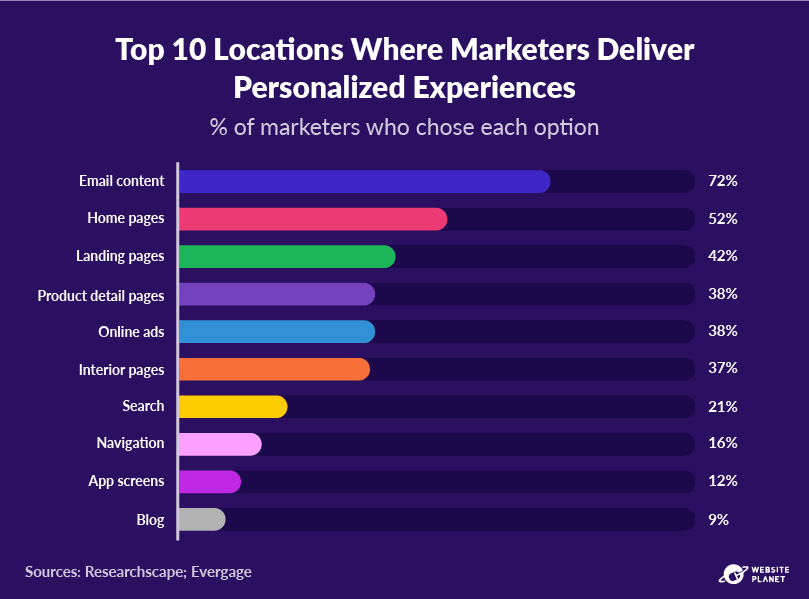 Where are marketers placing their personalized content within these channels?
Email content is the number 1 personalization location, which is expected given email’s popularity as a channel.
The homepage is personalized more than any other location on a website. Landing pages also receive a lot of attention from marketers.
Product detail pages feature a lot of personalization. This is most likely in the form of rules-based product recommendations (i.e. “customers who bought X also bought Y”).
Blog content is surprisingly low on the list. It suggests that personalized blog content marketing is not a priority for many marketers.
Where are marketers placing their personalized content within these channels?
Email content is the number 1 personalization location, which is expected given email’s popularity as a channel.
The homepage is personalized more than any other location on a website. Landing pages also receive a lot of attention from marketers.
Product detail pages feature a lot of personalization. This is most likely in the form of rules-based product recommendations (i.e. “customers who bought X also bought Y”).
Blog content is surprisingly low on the list. It suggests that personalized blog content marketing is not a priority for many marketers.
36. What Formats Are Personalized The Most?
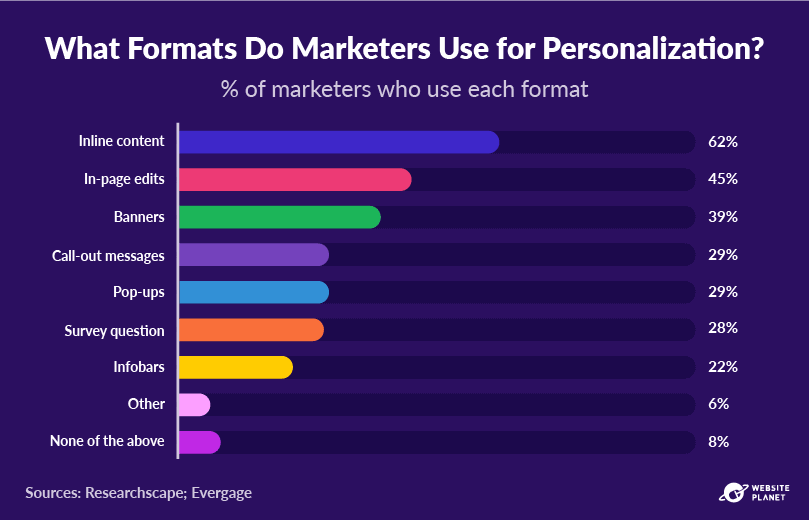 Marketers are placing personalized inline content within locations more than any other personalized format.
This owes to the importance of email personalization and on-site personalization. Various in-page edits are also used frequently by marketers, as are personalized banners.
Call-outs and pop-ups are personalized regularly, as well, and these are a great way to drive further engagement.
Marketers are placing personalized inline content within locations more than any other personalized format.
This owes to the importance of email personalization and on-site personalization. Various in-page edits are also used frequently by marketers, as are personalized banners.
Call-outs and pop-ups are personalized regularly, as well, and these are a great way to drive further engagement.
37. Marketers Should Personalize Websites and Apps
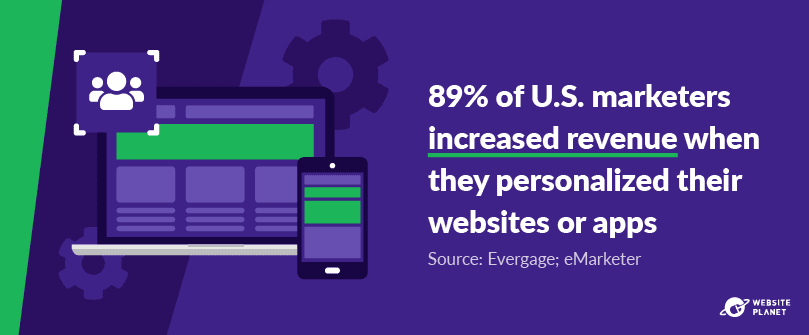 Personalizing a website or app certainly returns great results, that’s why websites are the second most popular channel for personalized tactics.
Personalizing online channels works to optimize the consumer’s experience of your business while upselling at every stage of the buyer’s journey. That’s why personalizing these 2 channels in particular drives big revenue increases.
Personalizing a website or app certainly returns great results, that’s why websites are the second most popular channel for personalized tactics.
Personalizing online channels works to optimize the consumer’s experience of your business while upselling at every stage of the buyer’s journey. That’s why personalizing these 2 channels in particular drives big revenue increases.
38. Mobile Recommendations Are Effective
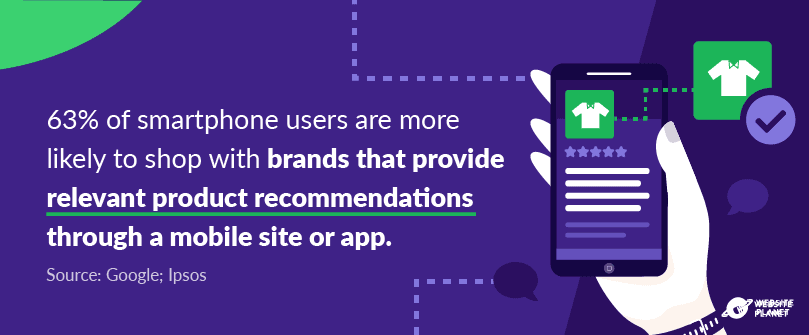 Though mobile personalization is underused by marketers, it is still super effective when done correctly.
Push notifications and product recommendations remain one of the primary ways to personalize customer experiences on mobile.
In fact, customers actually welcome mobile communications from brands. According to Instapage, 48% of customers are fine with brands delivering personalized messages to their smartphone, as long as they can opt in or out of communications.
Delivering these messages can be another driver of success. In a Sailthru study, 33% of brands send push notifications, and just 16% of brands send push notifications in response to customer behaviors.
These tactics are more common amongst the biggest brands in Sailthru’s study. 80% of the top 25 brands sent behavior-based push notifications, as opposed to a 16% average.
Push notifications are seriously underused!
Though mobile personalization is underused by marketers, it is still super effective when done correctly.
Push notifications and product recommendations remain one of the primary ways to personalize customer experiences on mobile.
In fact, customers actually welcome mobile communications from brands. According to Instapage, 48% of customers are fine with brands delivering personalized messages to their smartphone, as long as they can opt in or out of communications.
Delivering these messages can be another driver of success. In a Sailthru study, 33% of brands send push notifications, and just 16% of brands send push notifications in response to customer behaviors.
These tactics are more common amongst the biggest brands in Sailthru’s study. 80% of the top 25 brands sent behavior-based push notifications, as opposed to a 16% average.
Push notifications are seriously underused!
39. Mobile Users Want Consistent Experiences
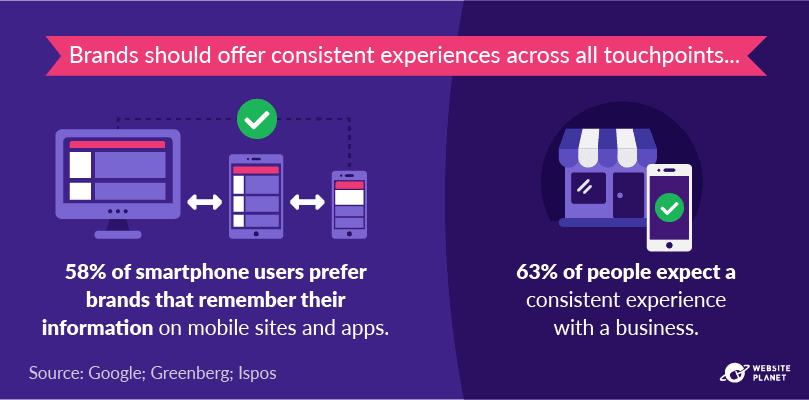 Customers crave consistent experiences across every touchpoint, and this is crucial when personalizing on mobile.
In Sailthru’s study, 43% of all brands maintained consistent experiences between their app and website, while 42% of all brands shared shopping carts across website and app.
Among the top 25% biggest businesses, 88% of retailers offer customers consistent experiences and a shared shopping cart across all channels.
Delivering a consistent and seamless customer experience is especially important on mobile. In a Harris Poll survey, 43% of customers said they expect brands to know who they are across every channel/touchpoint.
According to Instapage, 66% of consumers find it frustrating when shopping carts are not shared across channels.
Delivering consistent experiences can help alleviate these frustrations, which, in turn, increases sales performance. Omnichannel personalization can lead to a 5-15% increase in revenue and an increase in customer spending of 500%.
Customers crave consistent experiences across every touchpoint, and this is crucial when personalizing on mobile.
In Sailthru’s study, 43% of all brands maintained consistent experiences between their app and website, while 42% of all brands shared shopping carts across website and app.
Among the top 25% biggest businesses, 88% of retailers offer customers consistent experiences and a shared shopping cart across all channels.
Delivering a consistent and seamless customer experience is especially important on mobile. In a Harris Poll survey, 43% of customers said they expect brands to know who they are across every channel/touchpoint.
According to Instapage, 66% of consumers find it frustrating when shopping carts are not shared across channels.
Delivering consistent experiences can help alleviate these frustrations, which, in turn, increases sales performance. Omnichannel personalization can lead to a 5-15% increase in revenue and an increase in customer spending of 500%.
40. Marketers Are Getting Mobile Wrong
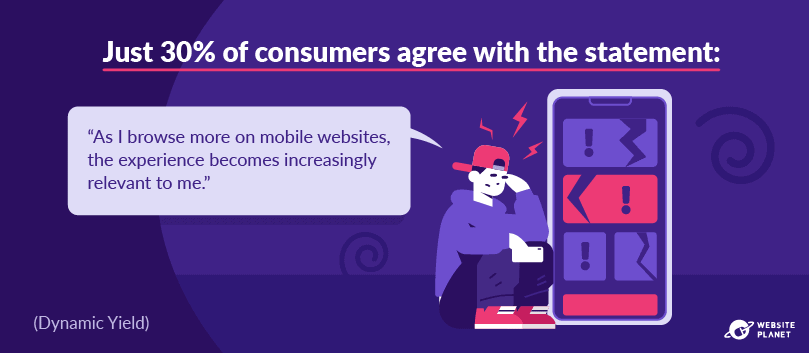 In general, marketers and businesses are getting customer experiences wrong on mobile. This suggests businesses could benefit from investing more in apps and other mobile channels.
Just 30% of consumers get an increasingly relevant brand experience on mobile. This can, of course, be solved with greater personalization. And businesses might want to solve this problem sooner rather than later.
The smaller screen means there is a greater importance on relevancy, simplicity, and optimization.
This means a bad customer experience is an instant issue for users on mobile: 65% of mobile users delete an app if their first experience with it is negative (Optimizely).
In general, marketers and businesses are getting customer experiences wrong on mobile. This suggests businesses could benefit from investing more in apps and other mobile channels.
Just 30% of consumers get an increasingly relevant brand experience on mobile. This can, of course, be solved with greater personalization. And businesses might want to solve this problem sooner rather than later.
The smaller screen means there is a greater importance on relevancy, simplicity, and optimization.
This means a bad customer experience is an instant issue for users on mobile: 65% of mobile users delete an app if their first experience with it is negative (Optimizely).
41. Marketers Collect Website & Email Data for Personalization
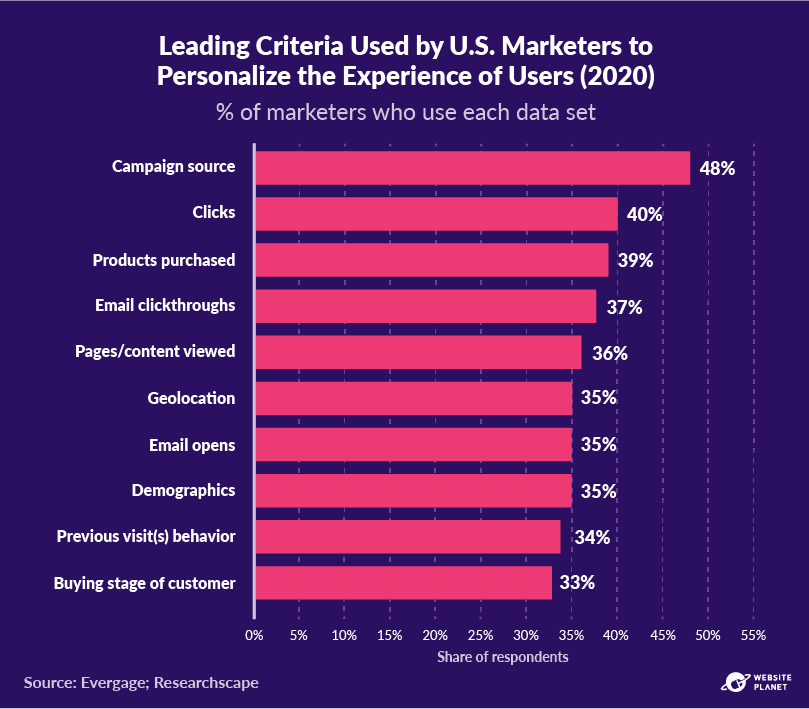 Marketers need data to personalize customer experiences.
48% of marketers are collecting data from the campaign source. This is the point at which contact between the consumer and the business originates.
That could mean the company is logging a consumer’s response to an advertisement.
Elsewhere, most of the data marketers collect comes from on-site behavior and email engagement.
Companies are tracking where users click on their site, while on-site purchases are tracked by another 39% of marketers.
Marketers also place an emphasis on tracking email click-throughs and opens, as is the importance of email campaigns.
Geolocation data is collected by 35% of marketers. This can be used to aid real-time content on-site and through email.
Marketers need data to personalize customer experiences.
48% of marketers are collecting data from the campaign source. This is the point at which contact between the consumer and the business originates.
That could mean the company is logging a consumer’s response to an advertisement.
Elsewhere, most of the data marketers collect comes from on-site behavior and email engagement.
Companies are tracking where users click on their site, while on-site purchases are tracked by another 39% of marketers.
Marketers also place an emphasis on tracking email click-throughs and opens, as is the importance of email campaigns.
Geolocation data is collected by 35% of marketers. This can be used to aid real-time content on-site and through email.
42. Personalizaed Web Experiences Boost Sales
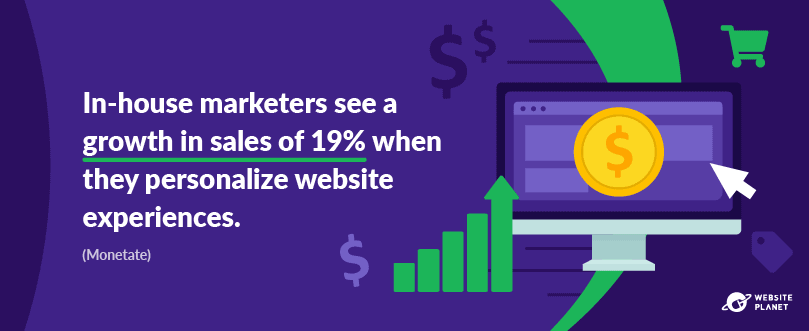 Website personalization lifts sales by nearly 20%. That’s a significant increase in revenue when marketers implement personalization elements such as banners, chatbots, and product recommendations.
Websites that aren’t eCommerce sites can benefit too…
Website personalization lifts sales by nearly 20%. That’s a significant increase in revenue when marketers implement personalization elements such as banners, chatbots, and product recommendations.
Websites that aren’t eCommerce sites can benefit too…
43. Targeted Pop-Ups Drive Action
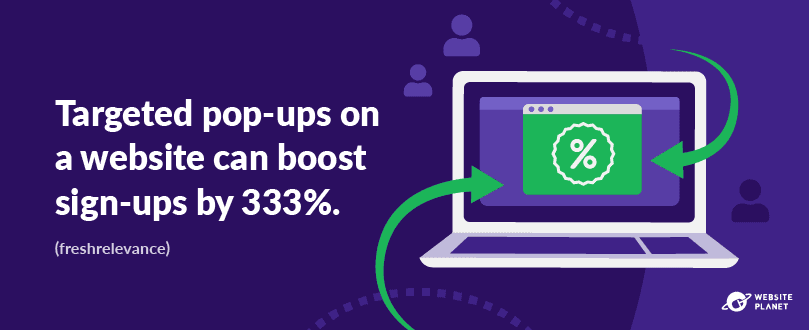 Targeted pop-ups are a personalized tactic used by almost every website. Pop-ups often appear when a user first lands on a webpage, and personalizing them can increase completions.
Users are likely to click away from pop-ups if they’re not personalized and relevant. However, targeted pop-ups boost their effectiveness, and can increase sign-ups by well over 300%.
Targeted pop-ups are a personalized tactic used by almost every website. Pop-ups often appear when a user first lands on a webpage, and personalizing them can increase completions.
Users are likely to click away from pop-ups if they’re not personalized and relevant. However, targeted pop-ups boost their effectiveness, and can increase sign-ups by well over 300%.
44. Obstacles to Website Personalization
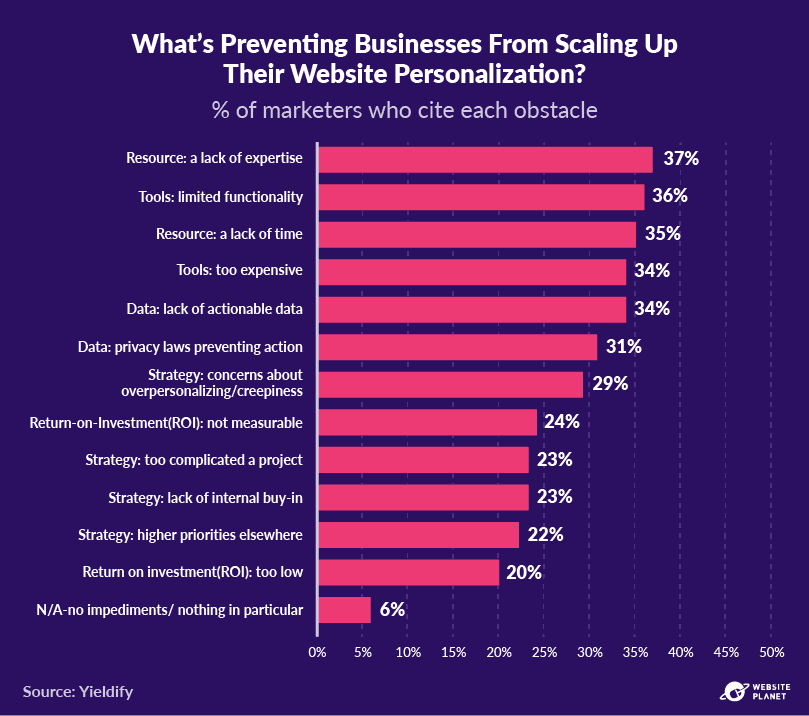 Yieldify put together a list of the biggest obstacles to adoption for websites. There are a few differences compared to general obstacles to scaling up personalization.
A lack of expertise is still a major concern to marketers on website channels, while marketers are also struggling with the expense and time it takes to implement personalization features.
There are some website-specific obstacles in Yieldify’s survey. 36% of marketers are prevented from upscaling due to the limited functionality of their personalization tools.
29% of marketers don’t want to scale up website personalization through fear of “creeping out” their customers. Though, as we’ve established, customers are generally willing to give over their data if they can receive something in return.
Marketers can solve this problem by using a targeted sign-up pop-up that promises offers in return.
Yieldify put together a list of the biggest obstacles to adoption for websites. There are a few differences compared to general obstacles to scaling up personalization.
A lack of expertise is still a major concern to marketers on website channels, while marketers are also struggling with the expense and time it takes to implement personalization features.
There are some website-specific obstacles in Yieldify’s survey. 36% of marketers are prevented from upscaling due to the limited functionality of their personalization tools.
29% of marketers don’t want to scale up website personalization through fear of “creeping out” their customers. Though, as we’ve established, customers are generally willing to give over their data if they can receive something in return.
Marketers can solve this problem by using a targeted sign-up pop-up that promises offers in return.
45. Personalized Emails Boost Revenues
 Email is the best channel to implement personalization. 87% of brands that use AI technology use it in their email campaigns, and segmented tactics are popular too. That’s because email personalization increases performance across a range of measurable metrics.
Chiefly, personalized campaigns can result in eye-watering increases in revenue. Demand Metric even notes that the median ROI for a personalized campaign sits at around 122%.
Research from Experian shows that personalized emails can boost email transaction rates 6 fold. This directly increases revenues, yet 70% of brands still fail to adopt personalized email campaigns.
Email is the best channel to implement personalization. 87% of brands that use AI technology use it in their email campaigns, and segmented tactics are popular too. That’s because email personalization increases performance across a range of measurable metrics.
Chiefly, personalized campaigns can result in eye-watering increases in revenue. Demand Metric even notes that the median ROI for a personalized campaign sits at around 122%.
Research from Experian shows that personalized emails can boost email transaction rates 6 fold. This directly increases revenues, yet 70% of brands still fail to adopt personalized email campaigns.
46. Marketers Should Personalize Email Messages
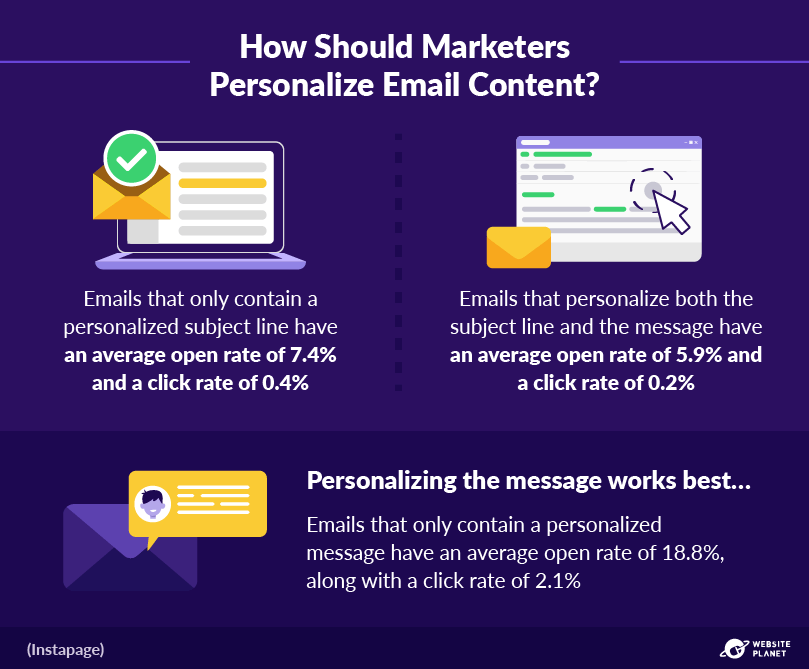 Personalized emails have a direct effect on open rates and click rates, which drive conversions and revenue.
Personalizing the email message wields a far higher return than subject line personalizations. Using a combination of the 2 decreases effectiveness, too, which suggests a lot of marketers are getting it wrong.
72% of consumers will only reply to emails that contain personalized messages (SmarterHQ). In which case, personalizing messages in your email campaign is crucial to success.
Clicks from customers are also more likely to be “unique” when messages are personalized. Unique clicks increase by 41% when mailings are personalized, meaning personalized campaigns are reaching a larger number of people.
Personalized emails have a direct effect on open rates and click rates, which drive conversions and revenue.
Personalizing the email message wields a far higher return than subject line personalizations. Using a combination of the 2 decreases effectiveness, too, which suggests a lot of marketers are getting it wrong.
72% of consumers will only reply to emails that contain personalized messages (SmarterHQ). In which case, personalizing messages in your email campaign is crucial to success.
Clicks from customers are also more likely to be “unique” when messages are personalized. Unique clicks increase by 41% when mailings are personalized, meaning personalized campaigns are reaching a larger number of people.
47. Effective Personalization Tactics in Email
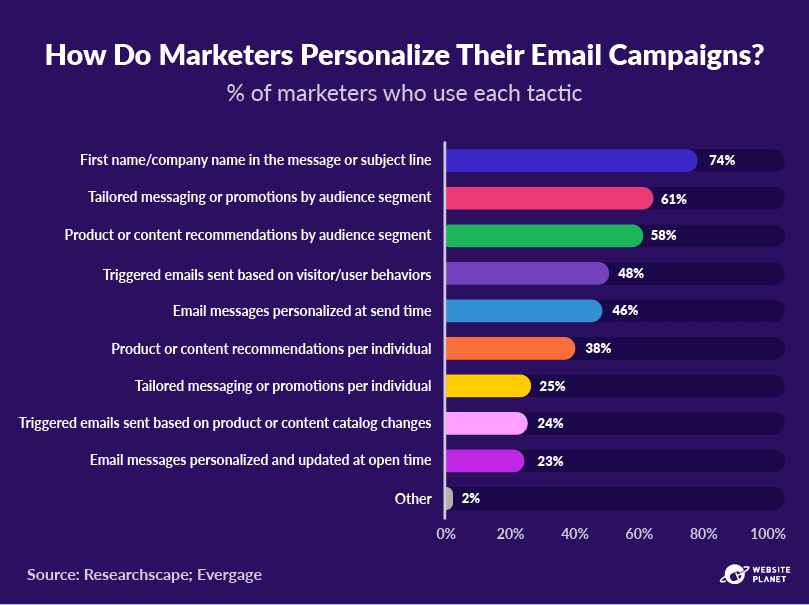 In Evergage and Researchscape’s study, email marketers revealed their favorite personalization tactics for email campaigns.
Content personalization is popular in email, with 74% of marketers personalizing either the email body or subject line with the recipient’s name. Segmented messaging tactics are second on the list, used by 61% of marketers, while product recommendations are another common personalization tactic on email.
Dynamic content does not feature amongst the top email marketing tactics. Most marketers are choosing simple rules-based forms of email personalization, yet email marketers could benefit from advanced AI elements.
In a separate survey by OneSpot, 65% of email marketers said dynamic content was the “most effective” personalization tactic in their arsenal.
In Evergage and Researchscape’s study, email marketers revealed their favorite personalization tactics for email campaigns.
Content personalization is popular in email, with 74% of marketers personalizing either the email body or subject line with the recipient’s name. Segmented messaging tactics are second on the list, used by 61% of marketers, while product recommendations are another common personalization tactic on email.
Dynamic content does not feature amongst the top email marketing tactics. Most marketers are choosing simple rules-based forms of email personalization, yet email marketers could benefit from advanced AI elements.
In a separate survey by OneSpot, 65% of email marketers said dynamic content was the “most effective” personalization tactic in their arsenal.
48. Creating Relevant Personalization Content Is Difficult
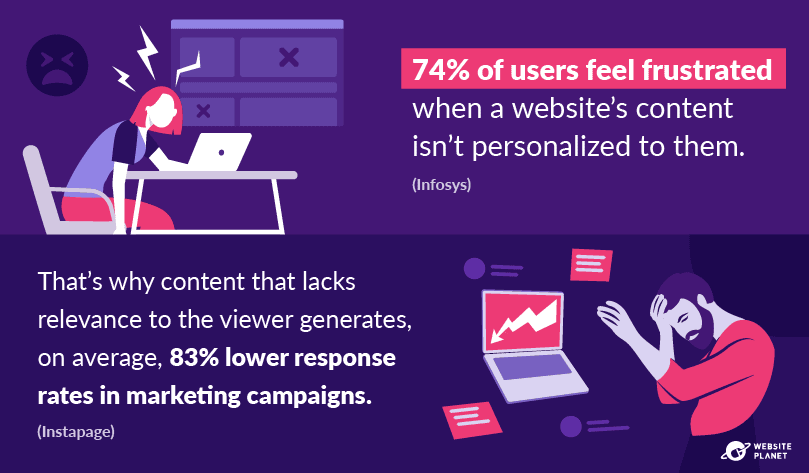 Although we’ve covered various aspects of content marketing throughout this article, it’s also important that we look specifically at personalized content.
Keeping content relevant through personalization is crucial. Not only does this improve response rates, but it also avoids user frustration by adding a personal touch.
Creating personalized content is not easy. 83% of marketers say that creating personalized content is the biggest challenge they face (Rapt Media).
Although we’ve covered various aspects of content marketing throughout this article, it’s also important that we look specifically at personalized content.
Keeping content relevant through personalization is crucial. Not only does this improve response rates, but it also avoids user frustration by adding a personal touch.
Creating personalized content is not easy. 83% of marketers say that creating personalized content is the biggest challenge they face (Rapt Media).
49. Dynamic Content Is Crucial
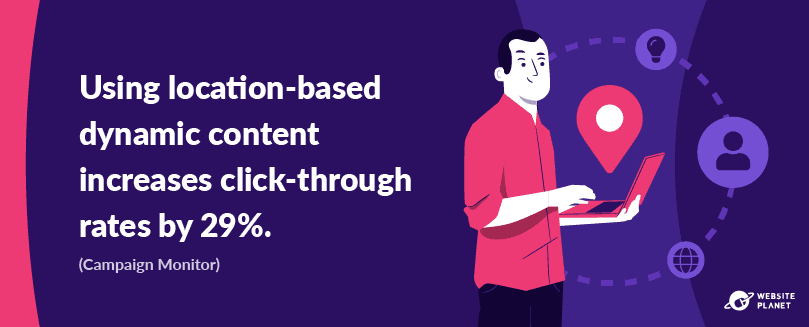 So relevant content is important, but real-time, dynamic content is even more effective.
Dynamic content personalizes the content in real-time based on the behavior of the viewer. This results in greater relevancy and a higher quality of content than, say, a message that contains the recipient’s name.
The quality of dynamic content means it can help your web page rank higher on search engines as well.
Again, this type of personalized content is so important and so difficult to get right. 77% of marketers believe real-time personalization is “crucial” to their success. Yet 60% of marketers struggle with dynamic, real-time content personalization (Adobe).
So relevant content is important, but real-time, dynamic content is even more effective.
Dynamic content personalizes the content in real-time based on the behavior of the viewer. This results in greater relevancy and a higher quality of content than, say, a message that contains the recipient’s name.
The quality of dynamic content means it can help your web page rank higher on search engines as well.
Again, this type of personalized content is so important and so difficult to get right. 77% of marketers believe real-time personalization is “crucial” to their success. Yet 60% of marketers struggle with dynamic, real-time content personalization (Adobe).
50. Use Personalized CTAs
 Personalized calls to action are a fantastic option to include in your content, whether you place CTAs within the body of an email, webpage, or blog post.
CTAs are already an effective marketing technique. Personalizing these messages makes them even more powerful. Including this personal touch increases the view-to-submission rate by over 40%, while conversions can increase by more than 200%.
Personalized calls to action are a fantastic option to include in your content, whether you place CTAs within the body of an email, webpage, or blog post.
CTAs are already an effective marketing technique. Personalizing these messages makes them even more powerful. Including this personal touch increases the view-to-submission rate by over 40%, while conversions can increase by more than 200%.
Approaches to Personalization
In section 5, we will look at the different approaches to personalization. That could be segmented/rules-based personalization, or more advanced AI techniques, such as predictive personalization.51. Understand The Personalization Maturity Curve
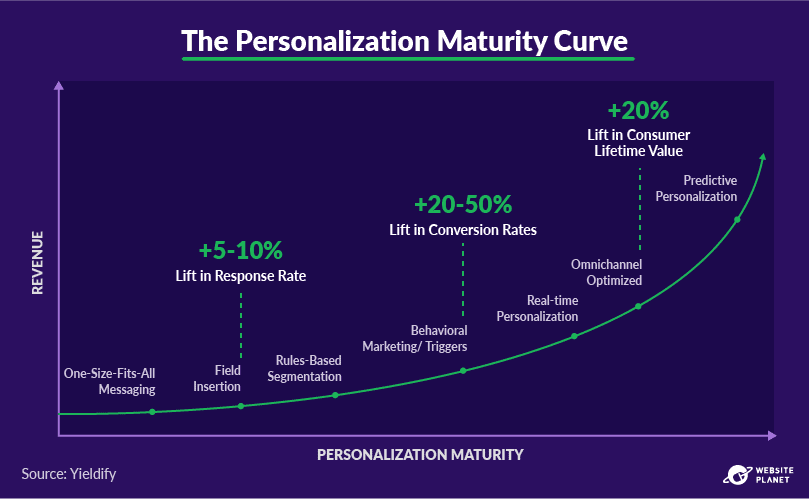 Yieldify’s “personalization maturity curve” shows the natural progression most businesses take when implementing personalization systems, and the effects businesses can expect as their personalization becomes “advanced.”
Mass messaging features no personalization. Meanwhile, rules-based segmentation is the most commonly used personalization tactic amongst businesses.
Rules-based personalization segments user data based on parameters set by the business. For example, the business may send personalized emails based on demographics information, or the target audience of the message.
Real-time personalization is further up the maturity curve and can see a 20-50% increase in conversions.
Predictive personalization is the most advanced form of personalization and can boost customer lifetime value.
Predictive personalization can predict a user’s behaviors and customize their experience accordingly. The most advanced predictive technologies can even provide personalization to unknown visitors.
Yieldify’s “personalization maturity curve” shows the natural progression most businesses take when implementing personalization systems, and the effects businesses can expect as their personalization becomes “advanced.”
Mass messaging features no personalization. Meanwhile, rules-based segmentation is the most commonly used personalization tactic amongst businesses.
Rules-based personalization segments user data based on parameters set by the business. For example, the business may send personalized emails based on demographics information, or the target audience of the message.
Real-time personalization is further up the maturity curve and can see a 20-50% increase in conversions.
Predictive personalization is the most advanced form of personalization and can boost customer lifetime value.
Predictive personalization can predict a user’s behaviors and customize their experience accordingly. The most advanced predictive technologies can even provide personalization to unknown visitors.
52. Popular Approaches to Personalization
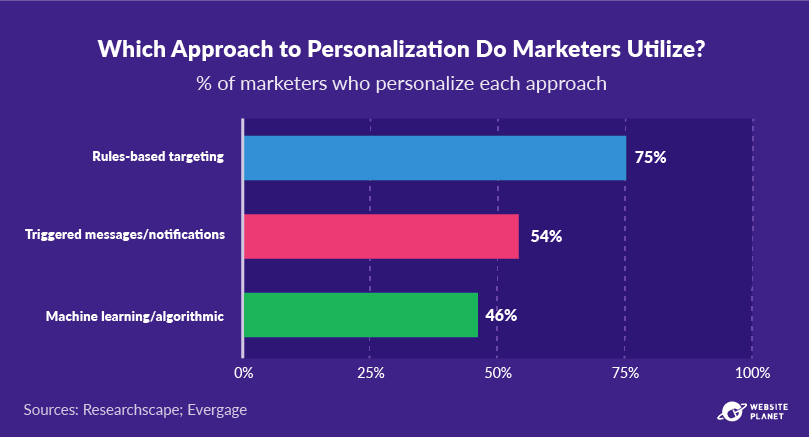 Researchscape asked marketers which approaches to personalization they take. As mentioned, rules-based targeting is common; 75% of marketers use this kind of targeting.
Triggered messages, such as shopping cart prompts, are used by 54% of marketers.
While the most advanced personalization tactics are shown to drive the best results, AI personalization is only used by 46% of marketers.
Research suggests that marketers recognize the value of AI personalization. Yet just 26% of marketers adopted machine-learning/algorithmic systems in 2018, while adoption for the other two categories has remained fairly consistent.
Researchscape asked marketers which approaches to personalization they take. As mentioned, rules-based targeting is common; 75% of marketers use this kind of targeting.
Triggered messages, such as shopping cart prompts, are used by 54% of marketers.
While the most advanced personalization tactics are shown to drive the best results, AI personalization is only used by 46% of marketers.
Research suggests that marketers recognize the value of AI personalization. Yet just 26% of marketers adopted machine-learning/algorithmic systems in 2018, while adoption for the other two categories has remained fairly consistent.
53. How Do Marketers Use A Customer Data Platform?
 Customer data platforms can be used to store customer data for rules-based targeting. These platforms offer turnkey solutions that simplify the logging and integration of data and marketing parameters.
Popular solutions include Segment, Bloomreach, and Insider. Researchscape asked marketers if they use a customer data platform: half of the respondents answered “yes” and the other 50% answered “no.”
50% of marketers are utilizing these systems to help with their rules-based segmentation campaigns. So, how are businesses using CDP systems?
30% of marketers use CDP systems as a data repository that can offer insights. 42% of marketers use these systems to segment customers into groups, while 28% use CDP platforms to personalize each and every customer’s experience.
Customer data platforms can be used to store customer data for rules-based targeting. These platforms offer turnkey solutions that simplify the logging and integration of data and marketing parameters.
Popular solutions include Segment, Bloomreach, and Insider. Researchscape asked marketers if they use a customer data platform: half of the respondents answered “yes” and the other 50% answered “no.”
50% of marketers are utilizing these systems to help with their rules-based segmentation campaigns. So, how are businesses using CDP systems?
30% of marketers use CDP systems as a data repository that can offer insights. 42% of marketers use these systems to segment customers into groups, while 28% use CDP platforms to personalize each and every customer’s experience.
54. Segmented Marketing is Reliable
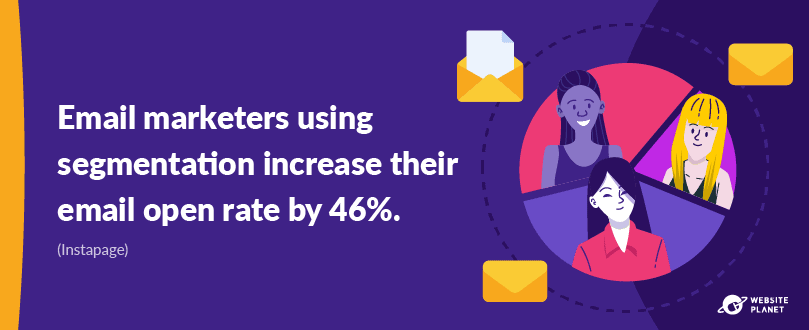 Rules-based segmentation is the common solution for marketers seeking personalized techniques. That being said, it is fairly simple.
The vast majority of email campaigns personalize their email campaigns based on “rules.” That could mean sending certain emails to some customers based on their age, gender, or working status.
Segmentation is more affordable than AI personalization and can return instant results. All reasons segmentation can give marketers a great return on investment.
Rules-based segmentation is the common solution for marketers seeking personalized techniques. That being said, it is fairly simple.
The vast majority of email campaigns personalize their email campaigns based on “rules.” That could mean sending certain emails to some customers based on their age, gender, or working status.
Segmentation is more affordable than AI personalization and can return instant results. All reasons segmentation can give marketers a great return on investment.
55. AI Is Hugely Effective In Personalized Marketing
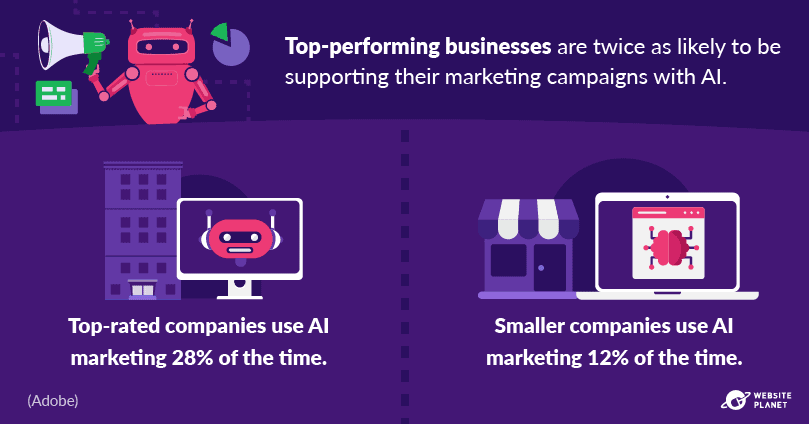 Despite the greater accessibility and instant impact of segmentation, data suggests marketers need to “bite the bullet” and commit to greater AI personalization.
Top companies are twice as likely to use advanced AI personalization because it provides better results.
AI personalization allows marketers to collect higher quality data, which ultimately provides more personalized experiences to a greater number of users.
Despite the greater accessibility and instant impact of segmentation, data suggests marketers need to “bite the bullet” and commit to greater AI personalization.
Top companies are twice as likely to use advanced AI personalization because it provides better results.
AI personalization allows marketers to collect higher quality data, which ultimately provides more personalized experiences to a greater number of users.
56. AI Engines Drive Profits
 AI engines are a widespread technology that’s used by marketers who employ AI personalization techniques.
AI personalization engines collect and analyze customer data in real-time to personalize the customer’s journey. They are responsible for those super-relevant product recommendations and offers you receive when shopping with your favorite eCommerce store.
AI engines are an advanced technology that is very effective. Netflix, for example, saved $1 billion in revenue when the company personalized its recommendation algorithm with an AI engine.
AI engines are a widespread technology that’s used by marketers who employ AI personalization techniques.
AI personalization engines collect and analyze customer data in real-time to personalize the customer’s journey. They are responsible for those super-relevant product recommendations and offers you receive when shopping with your favorite eCommerce store.
AI engines are an advanced technology that is very effective. Netflix, for example, saved $1 billion in revenue when the company personalized its recommendation algorithm with an AI engine.
5 Key Areas of Growth In Personalization
In this final section, we’ll take a look at 5 key areas of growth in personalization. These are the future trends in personalization that are expected by industry professionals. Preparing for these shifts in the market could see huge benefits further down the line!57. Big Data Growth
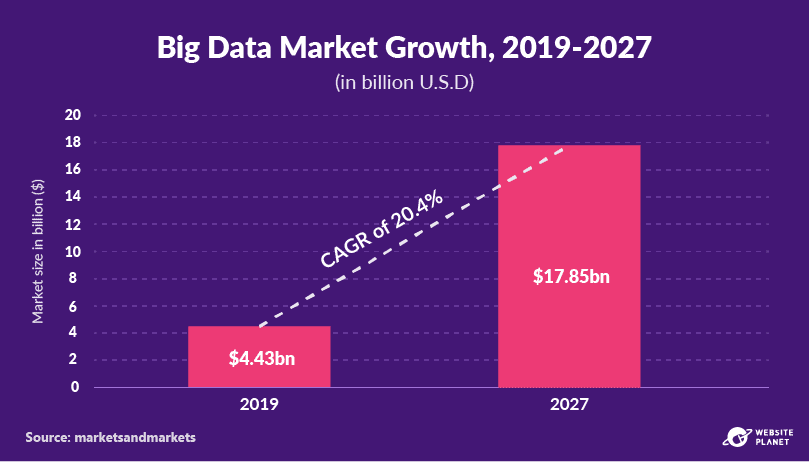 As companies continue to realize the importance of personalization and customer analysis, the big data industry will keep growing.
Companies are now collecting a huge range of information on buyers, from their habits to their physical characteristics.
This trend is expected to continue as personalized experiences become more bespoke, detailed, and individualized.
Retail’s emphasis on personalization will drive big data use within the industry, reaching $17.85 billion by 2027. The big data market as a whole is expected to reach $229.4 billion by 2025.
As companies continue to realize the importance of personalization and customer analysis, the big data industry will keep growing.
Companies are now collecting a huge range of information on buyers, from their habits to their physical characteristics.
This trend is expected to continue as personalized experiences become more bespoke, detailed, and individualized.
Retail’s emphasis on personalization will drive big data use within the industry, reaching $17.85 billion by 2027. The big data market as a whole is expected to reach $229.4 billion by 2025.
58. AI Will Continue to Grow
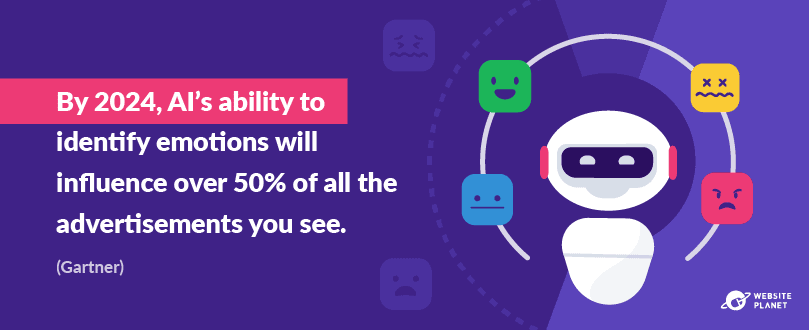 AI adoption will be a key driver of growth within personalization.
We’ve seen significant increases in AI use across all industries. Between 2015 and 2019, AI usage grew by 270%, and the market is now expected to reach around $126 billion by 2025.
Marketers will soon prioritize AI personalization over rules-based segmentation. The increased adoption of AI has been a theme since 2018, and at the current rate of growth, AI will influence more than half of the adverts you see by 2024.
AI adoption will be a key driver of growth within personalization.
We’ve seen significant increases in AI use across all industries. Between 2015 and 2019, AI usage grew by 270%, and the market is now expected to reach around $126 billion by 2025.
Marketers will soon prioritize AI personalization over rules-based segmentation. The increased adoption of AI has been a theme since 2018, and at the current rate of growth, AI will influence more than half of the adverts you see by 2024.
59. Voice-Based Shopping Will Rise
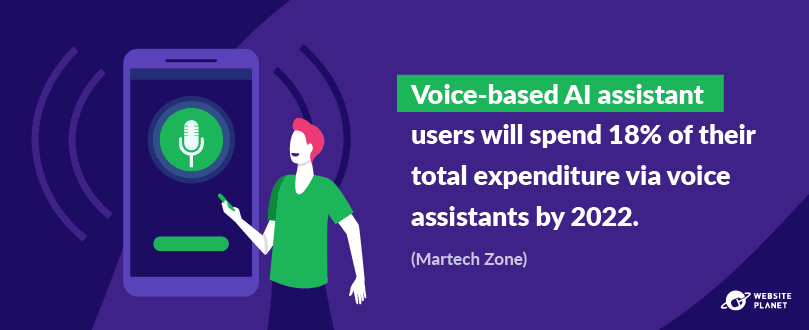 Another AI-led area of growth in personalization: voice-based shopping.
Voice-based shopping is a relatively new concept, but with popular AI assistants such as Google Assistant and Alexa now commonplace in households, the voice-based shopping market should reach $40 billion by 2022.
Voice-based shopping contains elements of personalization. It is a personalized and hugely streamlined customer experience, while machine-learning opens up opportunities for marketers to tailor the experience to each individual customer.
Spending by these means could reach nearly 20% by 2022, so marketers should begin to plan for greater adoption of the technology.
Another AI-led area of growth in personalization: voice-based shopping.
Voice-based shopping is a relatively new concept, but with popular AI assistants such as Google Assistant and Alexa now commonplace in households, the voice-based shopping market should reach $40 billion by 2022.
Voice-based shopping contains elements of personalization. It is a personalized and hugely streamlined customer experience, while machine-learning opens up opportunities for marketers to tailor the experience to each individual customer.
Spending by these means could reach nearly 20% by 2022, so marketers should begin to plan for greater adoption of the technology.
60. In-Store Personalization Will Become Normal
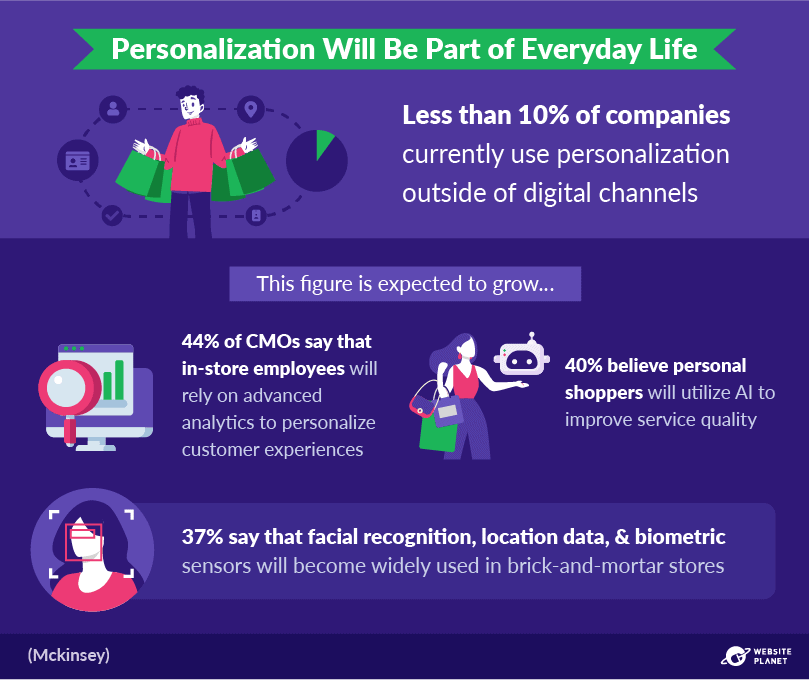 Just as the online spaces we inhabit become more focused on data and personalization, people can expect the same changes in everyday life.
Person-to-person interactions in-store stand to become “digitized.” Employees may reference your AI-collected data to personalize your in-store service, while other technologies such as facial recognition could tailor product recommendations as soon as you enter the store.
To be clear, the use of personalization in day-to-day spaces is currently low. Around 10% of companies surveyed by McKinsey were using personalization outside of digital channels.
However, the scope of opportunity here is huge. Expect this to be an emerging area of personalization over the next few years — one that could completely revitalize brick-and-mortar customer experiences.
Just as the online spaces we inhabit become more focused on data and personalization, people can expect the same changes in everyday life.
Person-to-person interactions in-store stand to become “digitized.” Employees may reference your AI-collected data to personalize your in-store service, while other technologies such as facial recognition could tailor product recommendations as soon as you enter the store.
To be clear, the use of personalization in day-to-day spaces is currently low. Around 10% of companies surveyed by McKinsey were using personalization outside of digital channels.
However, the scope of opportunity here is huge. Expect this to be an emerging area of personalization over the next few years — one that could completely revitalize brick-and-mortar customer experiences.
61. The Omnichannel Experience
 The need to provide fantastic customer experiences across a range of channels is already a focus for many marketers; a great omnichannel strategy can result in 89% customer retention rates.
Omnichannel marketing and integration stands to see significant growth within this context, as marketers continually work to streamline their omnichannel efforts.
Retail is the key driver of omnichannel growth. In retail, customers need relevant, personalized experiences across all touchpoints with a brand (think: shareable shopping carts across channels).
Expect significant market growth in the retail omnichannel industry. As customers are able to transition between channels more effortlessly, expect personalization across these channels to become integrated with every single facet of the customer’s experience.
The need to provide fantastic customer experiences across a range of channels is already a focus for many marketers; a great omnichannel strategy can result in 89% customer retention rates.
Omnichannel marketing and integration stands to see significant growth within this context, as marketers continually work to streamline their omnichannel efforts.
Retail is the key driver of omnichannel growth. In retail, customers need relevant, personalized experiences across all touchpoints with a brand (think: shareable shopping carts across channels).
Expect significant market growth in the retail omnichannel industry. As customers are able to transition between channels more effortlessly, expect personalization across these channels to become integrated with every single facet of the customer’s experience.


